 | –≠–ª–µ–∫—Ç—Ä–æ–Ω–Ω—ã–π –∫–æ–º–ø–æ–Ω–µ–Ω—Ç: TEA1069 | –°–∫–∞—á–∞—Ç—å:  PDF PDF  ZIP ZIP |

DATA SHEET
Product specification
Supersedes data of 1996 Dec 10
File under Integrated Circuits, IC03
1998 Jan 08
INTEGRATED CIRCUITS
TEA1069; TEA1069A
Versatile speech/dialler/ringer with
music-on-hold

1998 Jan 08
2
Philips Semiconductors
Product specification
Versatile speech/dialler/ringer with
music-on-hold
TEA1069; TEA1069A
FEATURES
Speech part
∑
Voltage regulator with adjustable static resistance
∑
Low DC line voltage; operates down to 1.6 V
(excluding polarity guard)
∑
Supply for dialler part and peripherals (not stabilized)
∑
Symmetrical high-impedance inputs (64 k
) for
dynamic, magnetic, or piezoelectric microphones
∑
Asymmetrical high-impedance input (32 k
) for electret
microphones
∑
Asymmetrical earpiece output for dynamic, magnetic,
or piezoelectric earpieces
∑
Internal mute to disable speech during dialling
∑
Confidence tone during DTMF dialling
∑
Line-loss compensation (line-current dependent) for
microphone and earpiece amplifiers
∑
Gain-control curve adaptable to the exchange supply.
Dialler part
∑
Pulse/DTMF and mixed mode dialling
∑
Last Number Redial (LNR), up to 32 digits
∑
13 repertory numbers (3 direct and 10 indirect) or
10 repertory numbers (10 direct), up to 32 digits,
with a maximum of 224 digits in total
∑
Repertory and redial memory integrity check
(memory contents check)
∑
Notepad memory function
∑
Flash and earth register recall
∑
Dial mode output
∑
Access pause generation and termination
∑
Function keys for: store, memory recall, register recall,
LNR, pause, hold, mute, hook
∑
Keytone generation
∑
Hands-free control
∑
Volume control in hands-free mode (VOL+/VOL
-
)
∑
Hold function
∑
Mute function
∑
Music-on-hold
∑
Diode options:
≠ DTMF tone burst/pause time
≠ make/break ratio
≠ access pause time
≠ pulse or DTMF mode selection
≠ register recall (earth and flash times)
≠ keyboard layout selection
≠ selection for german requirements
≠ hold/mute mode selection.
Ringer part
∑
Ringer input frequency discrimination
∑
Ringer melody generation (3-tone)
∑
Ringer melody selection/volume control via keyboard
∑
Diode option: ringer frequency selection.
GENERAL DESCRIPTION
The TEA1069 and TEA1069A contain all the functions
needed to build a highly featured, high-performance fully
electronic telephone set.
The device incorporates a speech/transmission part, a
dialler part and a ringer part. By offering a wide range of
possible adaptations for each part, the TEA1069 and
TEA1069A application can be easily adapted to meet
different requirements.
The TEA1069A offers some different timings and diode
options compared to the TEA1069.
Where pin numbers are mentioned in this data sheet we
refer to the TEA1069N, unless otherwise indicated.
Speech part
The speech/transmission part performs all speech and line
interface functions required in electronic sets. It operates
at line voltages down to 1.6 V DC to facilitate the use of
more telephones connected in parallel.
Dialler part
The dialler part offers a 32-digit Last Number Redial (LNR)
and 13 memories. Hands-free control is included allowing
the TEA1069 and TEA1069A to be used not only in basic
telephones, but also in feature phones offering hands-free
dialling via the TEA1083 call-progress monitor IC and/or
full hands-free operation via the TEA1093 hands-free IC.
The hold function allows the user to suspend the
conversation and resume the call either on the same
phone or on a parallel phone. Additionally through the
music-on-hold function a melody is transmitted while the
set is put on hold. The keytones provide in a buzzer an
audible feedback of a valid key pressed.
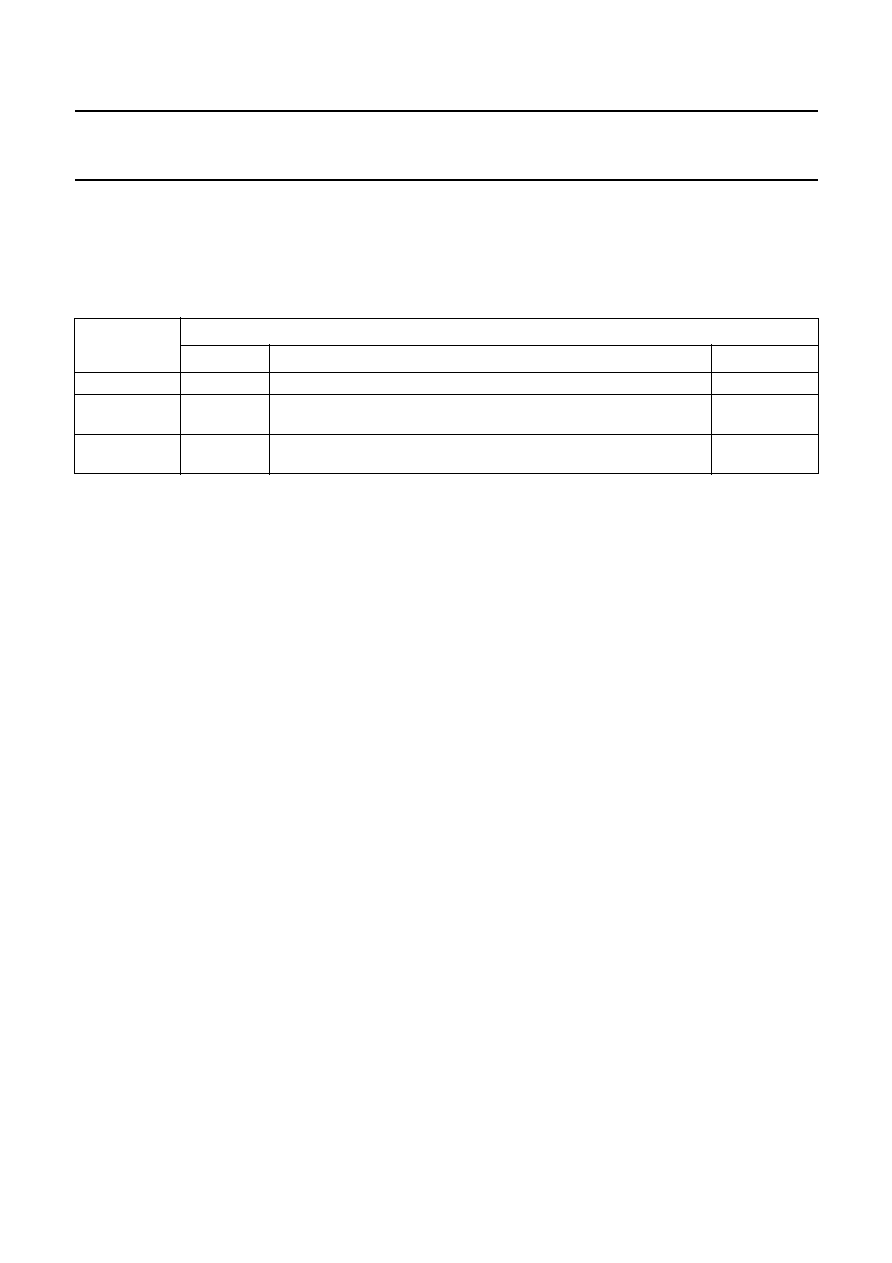
1998 Jan 08
3
Philips Semiconductors
Product specification
Versatile speech/dialler/ringer with
music-on-hold
TEA1069; TEA1069A
Ringer part
The ringer part offers a discriminator input which enables the tone output as soon as a valid ring frequency is detected.
It offers a melody based on 3 tones with programmable melody and volume via keyboard.
ORDERING INFORMATION
TYPE
NUMBER
PACKAGE
NAME
DESCRIPTION
VERSION
TEA1069N
SDIP42
plastic shrink dual in-line package; 42 leads (600 mil)
SOT270-1
TEA1069H
QFP44
plastic quad flat package; 44 leads (lead length 1.3 mm);
body 10
◊
10
◊
1.75 mm
SOT307-2
TEA1069AH
QFP44
plastic quad flat package; 44 leads (lead length 1.3 mm);
body 10
◊
10
◊
1.75 mm
SOT307-2

1998 Jan 08
4
Philips Semiconductors
Product specification
Versatile speech/dialler/ringer with
music-on-hold
TEA1069; TEA1069A
BLOCK DIAGRAM
handbook, full pagewidth
MBH195
34 (30)
KEYBOARD
DETECTOR
RECALL
KEY-
TONE
TONE
GENERATOR
TIMING/
CONTROL
DETECTOR/
GENERATOR
RINGER
33 (29)
DIODE
ROW5
32 (28)
ROW4
31 (27)
ROW3
30 (26)
ROW2
29 (25)
ROW1
14 (8)
COL6
15 (9)
COL5
16 (10)
COL4
17 (12)
COL3
18 (13)
COL2
19 (14)
COL1
9 (3)
CSI
10 (4)
XTAL1
11 (5)
XTAL2
12 (6)
RESET
13 (7)
25 (20)
CE/FDI
V
DD
HOLD
LOGIC
MUTE
RECEIVE
SECTION
PULSE
DIALLER
SPEECH
8
(2)
(24)
28
(19)
24
(21)
26
(17)
22
20
(15)
27
(22)
35
(31)
36
(32)
6
(44)
38
(34)
40
(36)
(40) 2
AGC
IR
MUTE
MOH/DMO
DP/FL
KT/EARTH
HF
TONE
VOL1
VOL2
(16)
21
HOLD
(33)
37
REG
(43)
5
STAB
(35)
39
SLPE
(1)
7
DTMF
(42)
4
MIC
+
(41)
3
MIC
-
(11, 18
and 23)
23
V
EE
V
CC
LN
TRANSMIT
SECTION
dB
SUPPLY
GAR
(37) 41
GAS1
(38) 42
GAS2
(39) 1
QR
TEA1069
TEA1069A
Fig.1 Block diagram.
Pin numbers in parenthesis refer to the TEA1069H and TEA1069AH.

1998 Jan 08
5
Philips Semiconductors
Product specification
Versatile speech/dialler/ringer with
music-on-hold
TEA1069; TEA1069A
PINNING
SYMBOL
PIN
DESCRIPTION
SOT270-1
SOT307-2
QR
1
39
receiving amplifier output
GAR
2
40
gain adjustment; receiving amplifier
MIC
-
3
41
inverting microphone input
MIC+
4
42
non-inverting microphone input
STAB
5
43
current stabilizer
IR
6
44
receiving amplifier input
DTMF
7
1
dual-tone multi-frequency input
KT/EARTH
8
2
keytone/earth recall output
CSI
9
3
cradle switch input
XTAL1
10
4
oscillator input
XTAL2
11
5
oscillator output
RESET
12
6
reset input
CE/FDI
13
7
chip enable/frequency discrimination input
COL6
14
8
keyboard column input 6
COL5
15
9
keyboard column input 5
COL4
16
10
keyboard column input 4
COL3
17
12
keyboard column input 3
COL2
18
13
keyboard column input 2
COL1
19
14
keyboard column input 1
DP/FL
20
15
dial pulse/flash output
HOLD
21
16
hold control input
VOL2
22
17
volume 2 output
V
EE
23
11, 18, 23
negative line terminal
TONE
24
19
tone generator output
V
DD
25
20
dialler/ringer part supply voltage
VOL1
26
21
volume 1 output
MOH/DMO
27
22
music on hold/dial mode output
HF
28
24
hands-free control output
ROW1
29
25
keyboard row input/output 1
ROW2
30
26
keyboard row input/output 2
ROW3
31
27
keyboard row input/output 3
ROW4
32
28
keyboard row input/output 4
ROW5
33
29
keyboard row input/output 5
DIODE
34
30
diode option output
MUTE
35
31
mute output, active LOW
V
CC
36
32
speech part supply voltage
REG
37
33
(DC) line voltage regulator decoupling
AGC
38
34
automatic gain control input
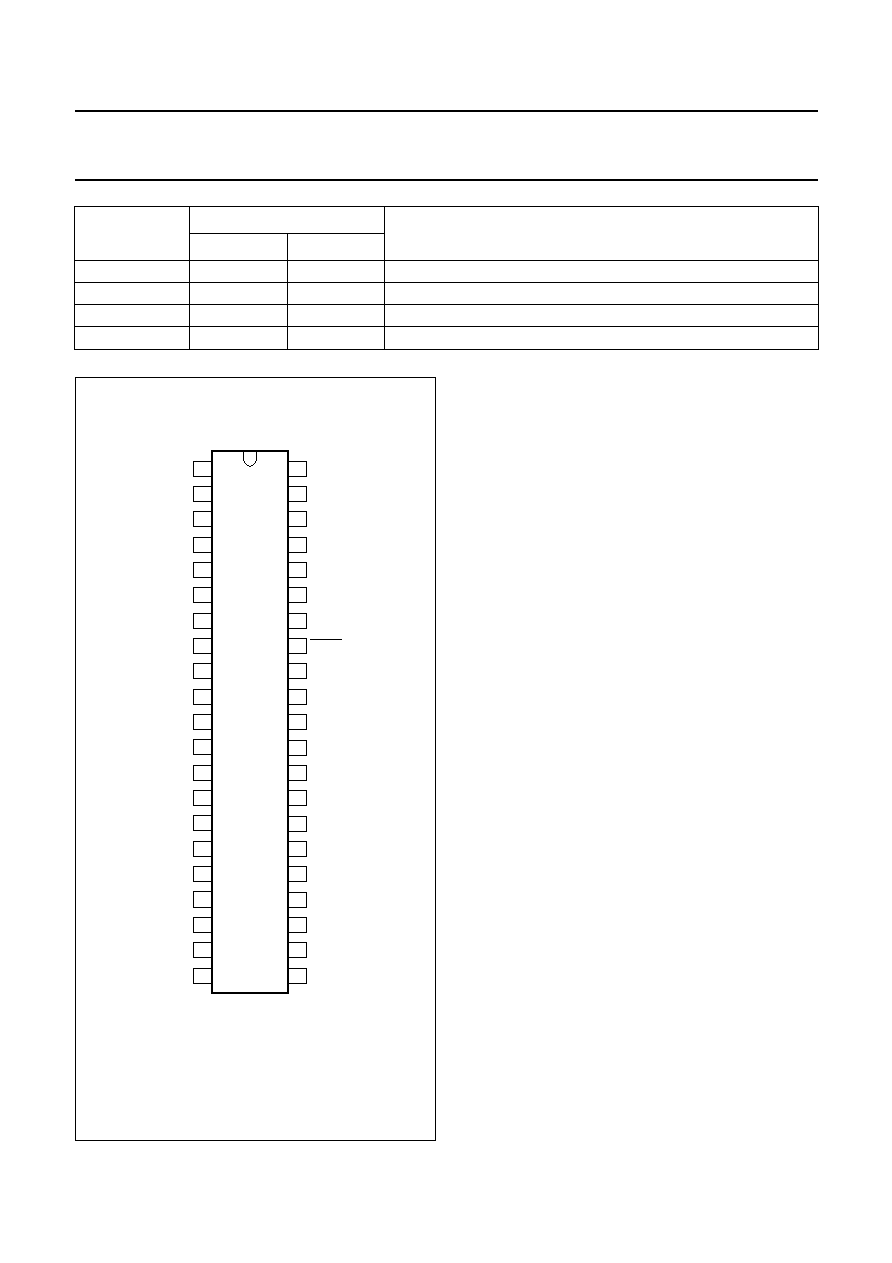
1998 Jan 08
6
Philips Semiconductors
Product specification
Versatile speech/dialler/ringer with
music-on-hold
TEA1069; TEA1069A
SLPE
39
35
slope (DC resistance) adjustment
LN
40
36
positive line terminal
GAS1
41
37
gain adjustment; transmitting amplifier
GAS2
42
38
gain adjustment; transmitting amplifier
SYMBOL
PIN
DESCRIPTION
SOT270-1
SOT307-2
Fig.2 Pin configuration (SOT270-1).
handbook, halfpage
TEA1069N
MBH196
1
2
42
41
3
4
5
6
7
8
9
10
11
12
13
14
15
16
17
18
19
20
40
39
38
37
36
35
34
33
32
31
30
29
28
27
26
25
24
23
22
21
QR
GAS2
GAR
GAS1
MIC
-
LN
MIC
+
SLPE
STAB
AGC
IR
REG
DTMF
VCC
KT/EARTH
MUTE
CSI
DIODE
XTAL1
ROW5
XTAL2
ROW4
RESET
ROW3
CE/FDI
ROW2
COL6
ROW1
COL5
HF
COL4
MOH/DMO
COL3
VOL1
COL2
VDD
COL1
TONE
DP/FL
VEE
HOLD
VOL2

1998 Jan 08
7
Philips Semiconductors
Product specification
Versatile speech/dialler/ringer with
music-on-hold
TEA1069; TEA1069A
Fig.3 Pin configuration (SOT307-2).
handbook, full pagewidth
TEA1069H
TEA1069AH
MBH784
1
2
3
4
5
6
7
8
9
10
11
33
32
31
30
29
28
27
26
25
24
23
12
13
14
15
16
17
18
19
20
21
22
44
43
42
41
40
39
38
37
36
35
34
DTMF
KT/EARTH
CSI
XTAL1
XTAL2
RESET
CE/FDI
COL6
COL5
COL4
VEE
COL3
COL2
COL1
DP/FL
HOLD
VOL2
V
EE
TONE
V
DD
VOL1
MOH/DMO
MUTE
DIODE
VCC
REG
ROW3
ROW2
ROW4
ROW5
VEE
HF
ROW1
IR
STAB
MIC
+
MIC
-
GAR
QR
GAS2
GAS1
LN
SLPE
AGC
FUNCTIONAL DESCRIPTION
Speech part
For numbering of components refer to Figs 28 and 29.
S
UPPLIES
V
CC
, LN, SLPE, REG
AND
STAB
Power for the IC and its peripheral circuits is usually
obtained from the telephone line (see Fig.4).
The circuit creates a stabilized voltage (V
ref
= 3.7 V)
between LN and SLPE. This reference voltage is
temperature compensated and can be adjusted by means
of an external resistor R
VA
. It can be increased by
connecting an R
VA
resistor (R60) between REG and SLPE
or decreased by connecting an R
VA
resistor (R61)
between REG and LN. This internal voltage reference is
decoupled by capacitor C3 between REG and V
EE
.
This decoupling capacitor realises the set impedance
conversion from its DC value to its AC value in the audio
frequency range.
The internal transmission part of the circuitry (including the
earpiece amplifier) is supplied from V
CC
. This voltage
supply is derived from the LN voltage via a dropping
resistor (R1) and must be decoupled by a capacitor (C1)
between V
CC
and V
EE
. This supply point may also be used
to supply the dialler/ringer (V
DD
) part or external circuit e.g.
electret microphone.
The DC current flowing into the set is determined by the
exchange supply voltage V
exch
, the feeding bridge
resistance R
exch
and the DC resistance of the telephone
line R
line
. When the line current (I
line
) is more than 0.5 mA
greater than the sum of the IC supply current (I
CC
) and the
current drawn by the peripheral circuitry connected to V
CC
(I
p
), the excess current is shunted to SLPE via LN.
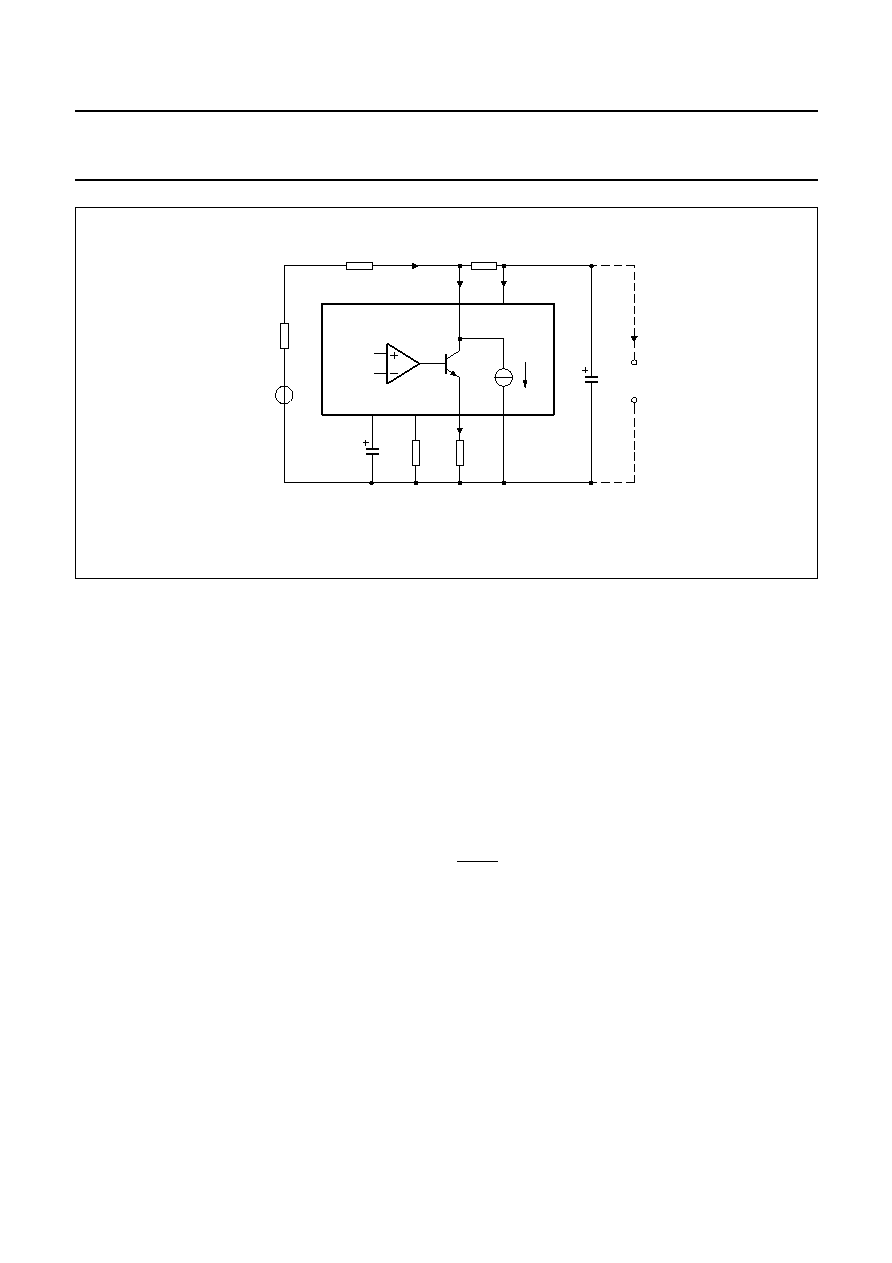
1998 Jan 08
8
Philips Semiconductors
Product specification
Versatile speech/dialler/ringer with
music-on-hold
TEA1069; TEA1069A
Fig.4 Supply arrangement.
handbook, full pagewidth
MBH197
SLPE
STAB
REG
LN
AC
DC
peripheral
circuits
C1
0.5 mA
Rline
Rexch
Vexch
Iline
Ip
R1
ICC
VCC
VEE
ISLPE
+
0.5 mA
ISLPE
C3
R5
R9
TEA1069
TEA1069A
Thus, the regulated voltage on the line terminal (V
LN
) can
be calculated as:
, where
V
ref
is the internally generated temperature compensated
reference voltage of 3.7 V and R9 is an external resistor
connected between SLPE and V
EE
.
The circuit has an internal current stabilizer operating at a
level determined by resistor R5 connected between STAB
and V
EE
.
In normal use the value of R5 would be 3.6 k
and the
value of R9 would be 20
.
Changing the value of R5 or R9 will affect microphone
gain, DTMF gain, gain control characteristics, sidetone
level, maximum output swing on LN and the DC
characteristics (especially at low line current).
At line currents below 9 mA the internal reference voltage
is automatically adjusted to a lower value (typically 1.6 V
V
LN
V
ref
I
SLPE
R9
◊
+
=
I
SLPE
I
line
I
CC
I
p
0.5
10
3
≠
A
◊
+
+
≠
=
at 1 mA). This means that more sets can be operated in
parallel with DC line voltages (excluding the polarity guard)
down to an absolute minimum voltage of 1.6 V. At line
currents below 9 mA the circuit has limited sending and
receiving levels.
Under normal conditions, when I
SLPE
>> I
CC
+ 0.5 mA + I
p
,
the static behaviour of the circuit is that of a 3.7 V regulator
diode (V
ref
) with an internal resistance equal to that of R9.
In the audio frequency range the dynamic impedance is
largely determined by R1. Figure 5 shows the equivalent
impedance of the circuit.
Current (I
p
) available from V
CC
for the dialler part and
peripheral circuits depends on the external components
used. Figure 6 shows this current for V
CC
> 2.2 V. When
MUTE is HIGH i.e. when the receiving amplifier (supplied
from V
CC
) is driven, the available current is further
reduced. Current availability can be increased by
connecting the supply IC TEA1081 in parallel with R1, or
by increasing the DC line voltage by means of an external
resistor (R
VA
= R60) connected between REG and SLPE.
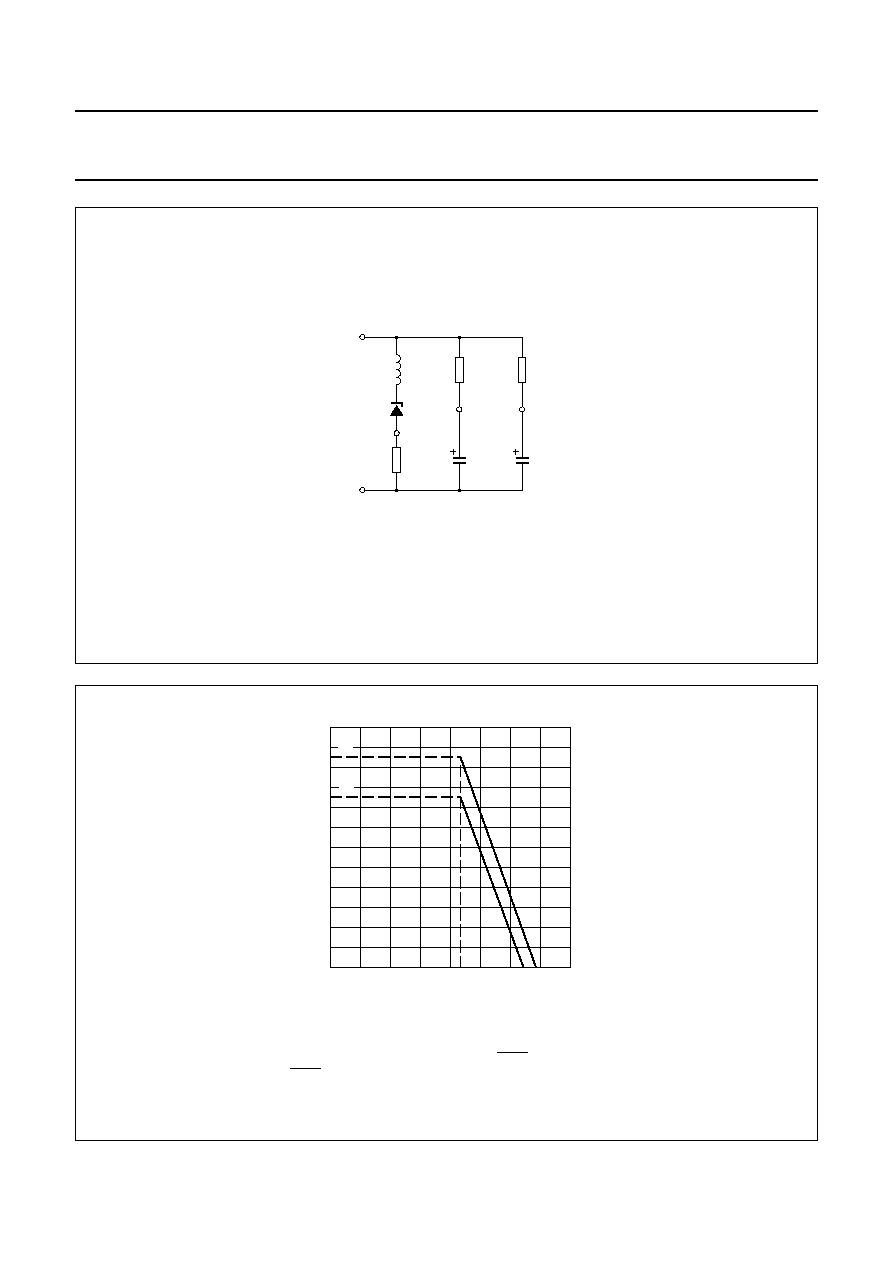
1998 Jan 08
9
Philips Semiconductors
Product specification
Versatile speech/dialler/ringer with
music-on-hold
TEA1069; TEA1069A
Fig.5 Equivalent impedance circuit.
L
eq
= C3
◊
R9
◊
R
p
.
R
p
= 16.2 k
.
handbook, halfpage
REG
SLPE
V
EE
VCC
LN
MGD489
Leq
R p
R1
V ref
R9
20
C3
4.7
µ
F
C1
100
µ
F
V
CC
> 2.2 V; I
line
= 15 mA at V
LN
= 4 V; R1 = 620
; R9 = 20
.
(1) I
p
= 2.1 mA. The curve is valid when the receiving amplifier is not driven or when MUTE = LOW.
(2) I
p
= 1.7 mA. The curve is valid when MUTE = HIGH and the receiving amplifier is driven; V
o(rms)
= 150 mV, R
L
= 150
.
Fig.6 Typical current I
P
available from V
CC
for peripheral circuitry.
handbook, halfpage
0
1
2
4
2.4
0
0.8
1.6
MSA504
3
V
CC
(V)
I p
(mA)
(1)
(2)

1998 Jan 08
10
Philips Semiconductors
Product specification
Versatile speech/dialler/ringer with
music-on-hold
TEA1069; TEA1069A
M
ICROPHONE INPUTS
MIC+
AND
MIC
-
AND GAIN PINS
GAS1
AND
GAS2
The circuit has symmetrical microphone inputs. Its input impedance is 64 k
(2
◊
32 k
) and its voltage gain is typically
52 dB (when R7 = 68 k
). Dynamic, magnetic, piezoelectric or electret (with built-in FET source followers) microphones
can be used. Microphone arrangements are illustrated in Fig.7.
Fig.7 Alternative microphone arrangements.
Pin numbers in parenthesis refer to the TEA1069H and TEA1069AH.
(1) Resistor may be connected to reduce the terminating impedance.
a. Magnetic or dynamic
microphone.
b. Electret microphone.
c. Piezoelectric microphone.
handbook, full pagewidth
MBH198
VEE
VCC
(1)
36 (32)
3 (41)
4 (42)
23 (18)
4 (42)
3 (41)
4 (42)
3 (41)
MIC
+
MIC
-
MIC
-
MIC
+
MIC
+
MIC
-
The gain of the microphone amplifier can be adjusted
between 44 dB and 52 dB to suit the sensitivity of the
transducer in use. The gain is proportional to the value of
R7 which is connected between GAS1 and GAS2. Stability
is ensured by two external capacitors, C6 connected
between GAS1 and SLPE and C17 connected between
GAS1 and V
EE
. The value of C6 is 100 pF but this may be
increased to obtain a first-order low-pass filter. The value
of C17 is 10 times the value of C6. The cut-off frequency
corresponds to the time constant R7
◊
C6.
R
ECEIVING AMPLIFIER
IR, QR
AND
GAR
The receiving amplifier has one input (IR) and one output
(QR). Earpiece arrangements are illustrated in Fig.8.
The IR to QR gain is typically 31 dB (when R4 = 100 k
).
It can be adjusted between 20 and 31 dB to match the
sensitivity of the transducer in use.
The gain is set with the value of R4 which is connected
between GAR and QR. The overall receive gain, between
LN and QR, is calculated by subtracting the anti-sidetone
network attenuation (32 dB) from the amplifier gain.
Two external capacitors, C4 and C7, ensure stability. C4 is
normally 100 pF and C7 is 10 times the value of C4.
The value of C4 may be increased to obtain a first-order
low-pass filter. The cut-off frequency will depend on the
time constant R4
◊
C4.
The output voltage of the receiving amplifier is specified for
continuous-wave drive. The maximum output voltage will
be higher under speech conditions where the peak to RMS
ratio is higher.
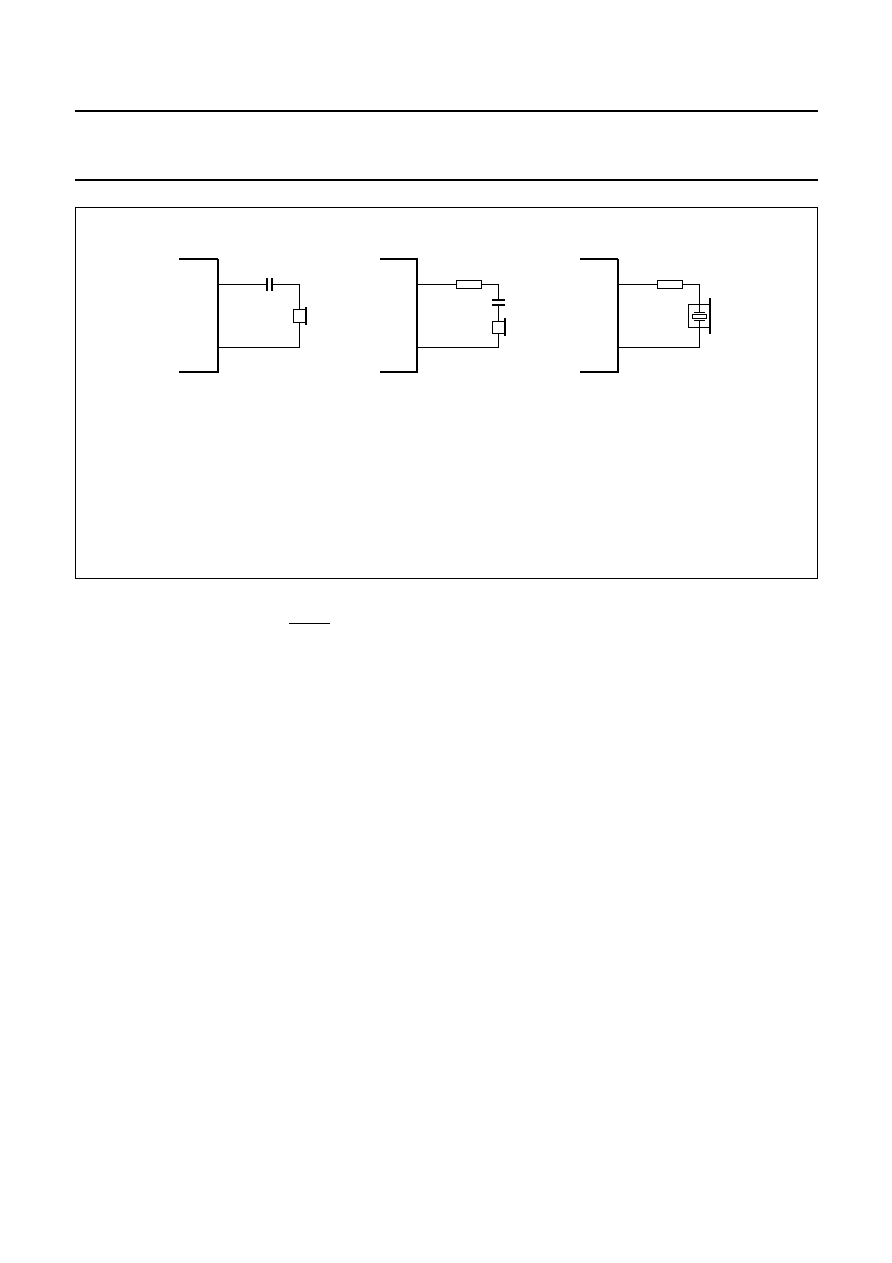
1998 Jan 08
11
Philips Semiconductors
Product specification
Versatile speech/dialler/ringer with
music-on-hold
TEA1069; TEA1069A
Fig.8 Alternative receiver arrangements.
Pin numbers in parenthesis refer to the TEA1069H and TEA1069AH.
(1) Resistor may be connected to prevent distortion (inductive load).
(2) Resistor is required to increase the phase margin (capacitive load).
a. Dynamic earpiece.
b. Magnetic earpiece.
c. Piezoelectric earpiece.
k, full pagewidth
(1)
(2)
QR
1 (39)
23 (18)
1 (39)
23 (18)
1 (39)
23 (18)
QR
QR
MBH199
VEE
VEE
VEE
D
UAL
T
ONE
M
ULTI
-F
REQUENCY INPUT
DTMF
When the DTMF input is enabled (MUTE is LOW) dialling
tones may be sent on to the line. The voltage gain from
DTMF to LN is typically 25.5 dB (when R7 = 68 k
) and
varies with R7 in the same way as the microphone gain.
The tones can be heard in the earpiece at a low level
(confidence tone).
A
UTOMATIC
G
AIN
C
ONTROL INPUT
AGC
Automatic line loss compensation is achieved by
connecting a resistor (R6) between AGC and V
EE
.
The automatic gain control varies the gain of the
microphone amplifier and the receiving amplifier in
accordance with the DC line current.
The control range is 5.8 dB which corresponds to a line
length of 5 km for a 0.5 mm diameter twisted-pair copper
cable with a DC resistance of 176
/km and average
attenuation of 1.2 dB/km. Resistor R6 should be chosen in
accordance with the exchange supply voltage and its
feeding bridge resistance (see Fig.9 and Table 1).
The ratio of start and stop currents of the AGC curve is
independent of the value of R6. If no automatic line-loss
compensation is required the AGC pin may be left
open-circuit. The amplifiers, in this condition, will give their
maximum specified gain.

1998 Jan 08
12
Philips Semiconductors
Product specification
Versatile speech/dialler/ringer with
music-on-hold
TEA1069; TEA1069A
Table 1
Values of resistor R6 for optimum line-loss compensation at various values of exchange supply voltage
(V
exch
) and exchange feeding bridge resistance (R
exch
); R9 = 20
V
exch
(V)
R6 (k
)
R
exch
= 400
R
exch
= 600
R
exch
= 800
R
exch
= 1000
36
100
78.7
-
-
48
140
110
93.1
82
60
-
-
120
102
Fig.9 Variation of gain as function of line current with R6 as parameter.
handbook, full pagewidth
MGD490
6
5.8
4
2
0
G v
(dB)
140
120
100
80
60
40
20
0
78.7 k
110 k
140 k
R6 =
I (mA)
line
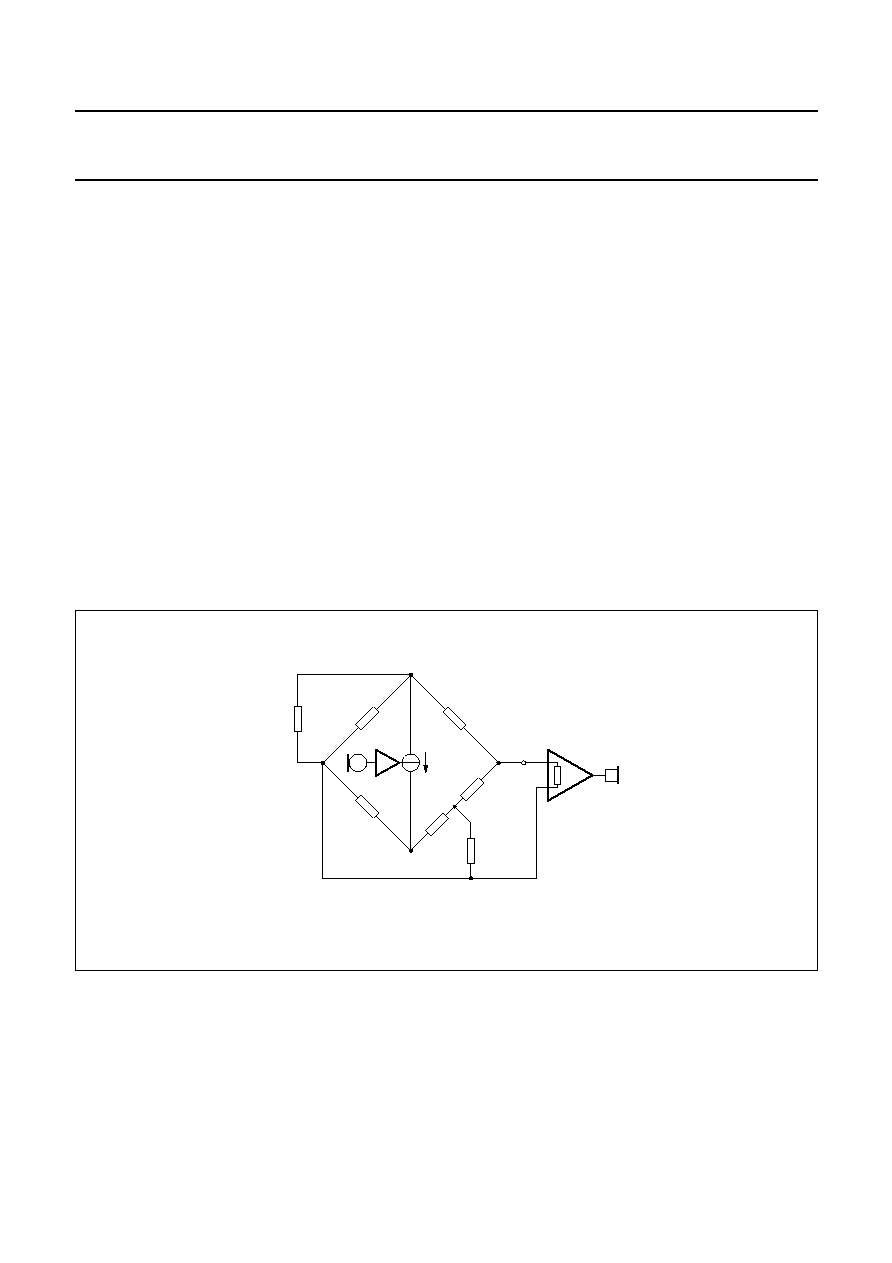
1998 Jan 08
13
Philips Semiconductors
Product specification
Versatile speech/dialler/ringer with
music-on-hold
TEA1069; TEA1069A
S
IDETONE SUPPRESSION
Suppression of the transmitted signal in the earpiece is
obtained by the anti-sidetone network comprising R1//Z
line
,
R2, R3, R8, R9 and Z
bal
(see Fig.10). The maximum
compensation is obtained when the following conditions
are fulfilled:
(1)
(2)
(3)
The scale factor k is chosen to meet the compatibility with
a standard capacitor from the E6 or E12 series for Z
line
.
In practice, Z
line
varies considerably with the line type and
length. Therefore, the value chosen for Z
bal
should be for
an average line length thus giving optimum setting for
short or long lines.
Example: the balance impedance Z
bal
at which the
optimum suppression is present can be calculated as
R9
R2
◊
R1
R3
R8
+
(
)
◊
=
k
R3
R8
R9
+
(
)
R2
R9
◊
(
)
-----------------------------
◊
=
Z
bal
k
Z
line
◊
=
follows:
suppose Z
line
= 210
+ (1265
//140 nF) representing a
5 km line of 0.5 mm diameter, copper, twisted-pair cable
matched to 600
(176
/km; 38 nF/km).
When k = 0.64 then R8 = 390
;
Z
bal
= 130
+ (820
//220 nF).
The anti-sidetone network for the TEA1069 and
TEA1069A shown in Fig.10 attenuates the signal received
from the line by 32 dB before it enters the receiving
amplifier.
The attenuation is almost constant over the whole
audio-frequency range. Figure 11 shows a conventional
Wheatstone bridge anti-sidetone circuit that can be used
as an alternative. Both bridge types can be used with
either resistive or complex set impedances. More
information on the balancing of anti-sidetone bridges can
be found in our publication
"Applications Handbook for
Wired telecom systems, IC03b", order number
9397 750 00811.
Fig.10 Equivalent circuit of TEA1069 and TEA1069A anti-sidetone bridge.
handbook, full pagewidth
MSA500 - 1
IR
R3
R8
SLPE
R9
Zline
VEE
Zbal
im
Rt
R1
R2
LN

1998 Jan 08
14
Philips Semiconductors
Product specification
Versatile speech/dialler/ringer with
music-on-hold
TEA1069; TEA1069A
Fig.11 Equivalent circuit of an anti-sidetone network in a Wheatstone bridge configuration.
handbook, full pagewidth
MSA501 - 1
IR
R8
SLPE
R9
R1
LN
Zline
VEE
Zbal
RA
im
Rt
Dialler and ringer part
S
UPPLY VOLTAGE
:
PINS
V
DD
AND
V
EE
The power supply must be maintained for data storage.
The RAM retention voltage (standby supply voltage) may
drop down to 1.0 V. Applying a large capacitor across the
supply terminals can retain the memory if power
connections are broken. The minimum operation voltage is
2.5 V. The internal power-on reset is enabled for a voltage
below this minimum operation voltage.
O
SCILLATOR INPUT
/
OUTPUT
:
PINS
XTAL1
AND
XTAL2
Time base for the TEA1069 and TEA1069A is a
crystal-controlled on-chip oscillator which is completed by
connecting a 3.579545 MHz crystal or ceramic resonator
between XTAL1 and XTAL2. The oscillator starts when
V
DD
reaches the operation voltage level and
CE/FDI = HIGH. The following types of ceramic
resonators are recommended:
∑
Kyocera PBRC3.58ARPC10 (wired)
∑
Kyocera KBR3.58MSATRPC10 (SMD)
∑
Murata CSA3.58MG310VA (wired).
R
ESET INPUT
:
PIN
RESET
Pin RESET is an input to the internal reset circuit. When
RESET = HIGH, it can be used to initialize the TEA1069
and TEA1069A which is normally done by the CE/FDI
input. The on-chip power-on reset generates a reset pulse
if V
DD
drops below 2.5 V. In this event a proper start-up
occurs after the supply voltage rises above the minimum
operation voltage level again.
During and directly after reset pins 14 to 19, 21, 29 to 32,
34 and 35 are set HIGH; pins 8, 20, 22, 26 to 28 and 33
are set to LOW.
The RESET pin can be connected to V
EE
, preferably via a
resistor of 100 k
to 1 M
, which will save leakage
current. A capacitor connected to V
DD
can be used to
extend the reset time, in case a longer reset is desirable.
To prevent the dialler from reacting on voltage
disturbances on the telephone line a time-out is active.
The dialler returns to standby state if the voltage on the line
has disappeared for more than this reset-delay time (t
rd
).
C
HIP
E
NABLE
/F
REQUENCY
D
ISCRIMINATOR
I
NPUT
:
PIN
CE/FDI
This active HIGH input is used to initialize part of the
system, to select the on-line, standby, or ringer mode and
to detect line power breaks. To keep the TEA1069 and
TEA1069A in the on-line mode, CE/FDI has to be HIGH.
In the exchange, several AC signals can be superimposed
on the DC signal, e.g. dialling tone, busy tone,
disturbances (like line power breaks), and the ringer
signal. The ringer signal is evaluated, and checked if its
frequency is within the limits of the frequency interval as
set by the diode option RFS. It is assumed that the ringer
frequency at pin CE/FDI is the double of the frequency
present on the telephone line.
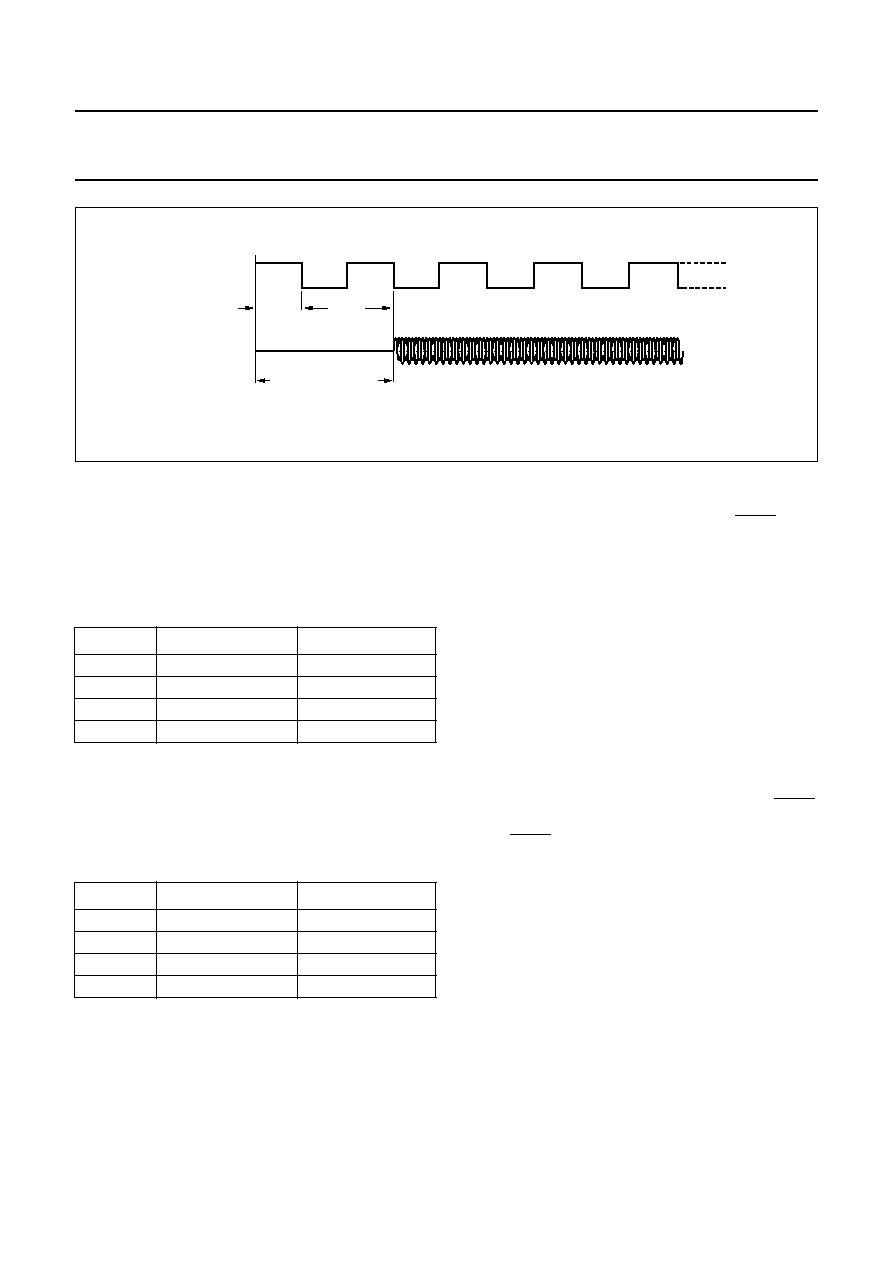
1998 Jan 08
15
Philips Semiconductors
Product specification
Versatile speech/dialler/ringer with
music-on-hold
TEA1069; TEA1069A
Fig.12 Ringer frequency detection.
handbook, full pagewidth
CE/FDI
TONE
MBH200
VDD
VEE
sample
time
ringer response delay
(
<
1.5 frequency cycle)
sync
time
In case of a valid ringer signal the user is alerted through
a melody at the TONE output, generated by the ringer part
of the TEA1069 and TEA1069A. This melody follows the
cadence of the ringer signal. Both the melody and the
volume can be selected. The melody frequency and
duration are given in Table 2.
Table 2
Ringer melodies
C
RADLE SWITCH INPUT
:
PIN
CSI
To distinguish among different operating states after
CE/FDI is activated, input CSI is used. The basic states
are shown in Table 3.
Table 3
TEA1069 and TEA1069A basic states
NAME
FREQUENCY (Hz)
DURATION (ms)
Bell 1
800 + 1066 + 1333
28 + 28 + 28
Bell 2
826 + 925 + 1027
28 + 28 + 28
Bell 3
1037 + 1161 + 1297 28 + 28 + 28
Bell 4
1297 + 1455 + 1621 28 + 28 + 28
INPUT CSI
INPUT CE/FDI
STATE
LOW
LOW
standby
HIGH
LOW
not applicable
LOW
HIGH
ringer
HIGH
HIGH
on-line
For the hands-free state refer to Fig.23.
P
ULSE DIALLER
:
PINS
DP/FL, MOH/DMO
AND
MUTE
The pulse dialling system uses line current interruptions to
signal the digits dialled to the exchange. The number of
line current interruptions corresponds with the digit dialled
except for the digit [0] which is characterized by
10 interruptions. Before each digit there is an inter-digit
pause.
Valid keys are the digits [0] to [9] and [PAUSE].
The pulse dialling mode, the make/break ratio and the
access pause time depend on the diode options: PTS,
M/B, APT and APT2. DP/FL is LOW when V
DD
is below
power-on reset trip level and when RESET is HIGH.
The MOH/DMO pin (diode GOS = on) is used to reduce
the voltage swing over the a/b terminals during pulse
dialling. Several countries require this feature. The MUTE
pin is an open drain output which requires a pull-up
resistor. MUTE is HIGH when V
DD
is below power-on reset
trip level and when RESET is HIGH.
Figure 13 shows the timing diagram in pulse dialling mode
when keys [3], [RECALL] and [4] are pressed.

1998 Jan 08
16
Philips Semiconductors
Product specification
Versatile speech/dialler/ringer with
music-on-hold
TEA1069; TEA1069A
Fig.13 Timing diagram in pulse dialling mode.
t
b
= break time.
t
m
= make time.
t
idp
= interdigit pause time.
t
rc
= recall time.
t
holdover
= hold-over time.
t
interflash
= interflash hold-over time (only for TEA1069A).
handbook, full pagewidth
MBH201
[3]
KEYS
MUTE
DP/FL
MOH/DMO
[recall]
[4]
tidp
tb
tm
tm
+
tholdover
tholdover
tinterflash
trc
T
ONE DIALLER
:
PINS
TONE
AND
MUTE
In this system digits are transmitted as two tones
simultaneously, the so called Dual-Tone Multi-Frequency
(DTMF) system. Tone digits are separated by a pause
time. Valid keys are the digits [0] to [9], [
], [#] and
[PAUSE].
The DTMF dialling mode, the tone burst/pause times and
the access pause time depend on the diode options: PTS,
TBT, APT and APT2.
The MUTE pin is an open drain output which requires a
pull-up resistor. MUTE is HIGH when V
DD
is below
power-on reset trip level and when RESET is HIGH.
Figure 14 shows the timing diagram in tone dialling mode
when successively keys [3], [3], [RECALL] and [4] are
dialled.

1998 Jan 08
17
Philips Semiconductors
Product specification
Versatile speech/dialler/ringer with
music-on-hold
TEA1069; TEA1069A
The DC-level at the TONE output measures
1
/
2
V
DD
and the impedance is typically 100
. DTMF frequencies are
composed by transmitting 2 tones simultaneously at pin TONE. The frequency tolerance for the tones at output TONE
is shown in Table 4.
Table 4
DTMF frequency tolerances
DTMF FREQUENCY
FREQUENCY AT TONE
DEVIATION (%)
DEVIATION (Hz)
697
697.90
+0.13
+0.90
770
770.46
+0.06
+0.46
852
850.45
-
0.18
-
1.55
941
943.23
+0.24
+2.23
1209
1206.45
-
0.21
-
2.55
1336
1341.66
+0.42
+5.66
1477
1482.21
+0.35
+5.21
Fig.14 Timing diagram in tone dialling mode.
t
t
= burst time.
t
p
= pause time.
t
holdover
= hold-over time.
t
rc
= recall time.
t
interflash
= interflash hold-over time (only for TEA1069A).
Note: in case of manual dialling only the minimum tone burst and pause time values depend on the chosen diode option, the maximum tone burst/pause
times are equal to the real key press/release time.
handbook, full pagewidth
MBH202
[3]
[3]
MUTE
KEYS
DP/FL
TONE
[recall]
[4]
tt
tp
tp + tholdover
tholdover
trc
tinterflash
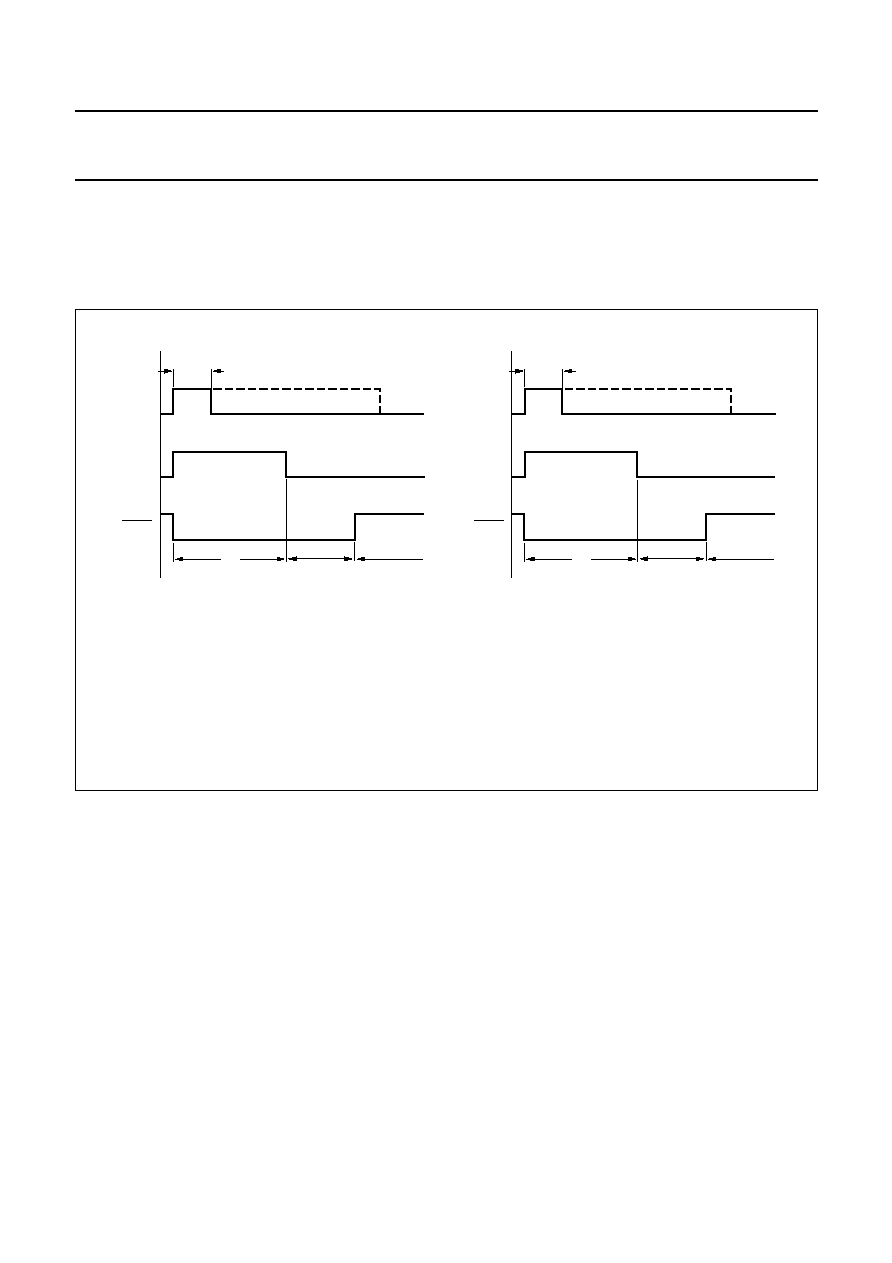
1998 Jan 08
18
Philips Semiconductors
Product specification
Versatile speech/dialler/ringer with
music-on-hold
TEA1069; TEA1069A
R
EGISTER RECALL
:
PINS
DP/FL
AND
KT/EARTH
The RECALL function results in a calibrated pulse which drives the electronic line current interrupter via pin DP/FL or
KT/EARTH. Flash or earth selection and various flash interruption times depend on the diode options: FES A and FES B
(diode GOS = on; see Fig.15).
Fig.15 Recall mode timing diagram.
t
kd
= key pressed time (depends on user).
t
holdover
= hold-over time.
t
idp
= interdigit pause time.
t
interflash
= interflash hold-over time (only for TEA1069A).
a. Recall using flash; t
rc
= recall time using flash.
b. Recall using earth; t
ea
= recall time using earth.
handbook, full pagewidth
MBH203
recall
KEY
DP/FL
trc
tholdover
MUTE
tkd
tholdover
recall
KEY
KT/EARTH
tea
MUTE
tkd
tinterflash
tidp
K
EYBOARD
:
PINS
ROW1
TO
ROW5
AND
COL1
TO
COL6
The sense columns inputs and scanning rows outputs are
directly connected to a single contact keyboard matrix.
A second key entry will be valid after having released the
first button and after having pressed the second button.
Simultaneously pressing 2 buttons will disable the first
entered key. A key entry becomes valid when the
debounce time t
d
has elapsed.
The column and row pins (except ROW5) are HIGH when
V
DD
is below power-on reset trip level and when RESET is
HIGH.
ROW5 is an open-drain input/output; this configuration is
used to avoid current flowing in the on-line or standby
state. A pull-up resistor should be connected to ROW5.
ROW5 is LOW when V
DD
is below power-on reset trip level
and when RESET is HIGH.

1998 Jan 08
19
Philips Semiconductors
Product specification
Versatile speech/dialler/ringer with
music-on-hold
TEA1069; TEA1069A
Keyboard layout
The TEA1069 and TEA1069A support three different keyboard layouts:
∑
With 10 direct accessible repertory numbers
∑
With 10 indirect accessible repertory numbers
∑
With 3 direct accessible repertory numbers and 10 indirect numbers.
For layouts see Figs 17 to 19; the keyboard layout can be selected by diode option KBS.
Fig.16 Timing diagram debouncing.
t
d
= debounce time.
handbook, full pagewidth
MBH204
key entry
td
key valid
td
Fig.17 Keyboard and diodes with 10 direct accessible repertory numbers.
handbook, full pagewidth
1
ROW1
4
ROW2
7
ROW3
*
/T
ROW4
RECALL
ROW5
M/B
DIODE
COL1
2
5
8
0
PAUSE/
LNR
RFS
COL2
3
6
9
#
COL3
STORE
MRC
VOL
+
VOL
-
HOOK
HMS
APT2
COL4
M1
M3
M5
M7
M9
APT
COL5
M2
M4
M6
M8
M10
PTS
COL6
DIODE
FES A
FES B
TBT
GOS
KBS
MBH205
HOLD/
MUTE
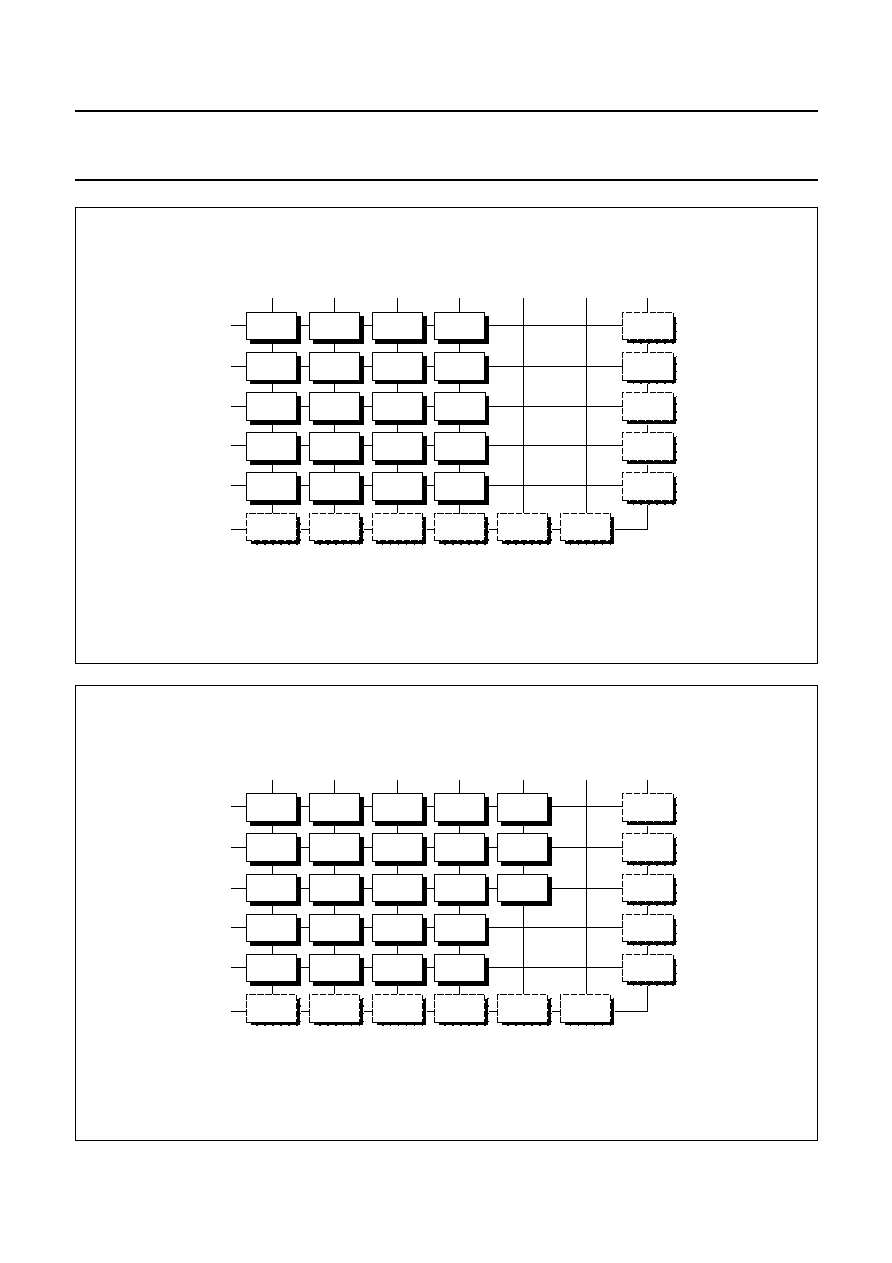
1998 Jan 08
20
Philips Semiconductors
Product specification
Versatile speech/dialler/ringer with
music-on-hold
TEA1069; TEA1069A
Fig.18 Keyboard and diodes with 10 indirect accessible repertory numbers.
handbook, full pagewidth
1
ROW1
4
ROW2
7
ROW3
ROW4
RECALL
ROW5
M/B
DIODE
COL1
2
5
8
0
PAUSE/
LNR
RFS
COL2
3
6
9
#
COL3
STORE
MRC
VOL
+
VOL
-
HOOK
HMS
APT2
COL4
APT
COL5
PTS
COL6
DIODE
FES A
FES B
TBT
GOS
KBS
MBH206
HOLD/
MUTE
*
/T
Fig.19 Keyboard and diodes with 3 direct and 10 indirect accessible repertory numbers.
handbook, full pagewidth
1
ROW1
4
ROW2
7
ROW3
ROW4
RECALL
ROW5
M/B
DIODE
COL1
2
5
8
0
PAUSE/
LNR
RFS
COL2
3
6
9
#
COL3
STORE
MRC
VOL
+
VOL
-
HOOK
HMS
COL4
M1
M2
M3
APT
COL5
PTS
COL6
DIODE
FES A
FES B
TBT
GOS
KBS
MBH207
HOLD/
MUTE
*
/T
APT2
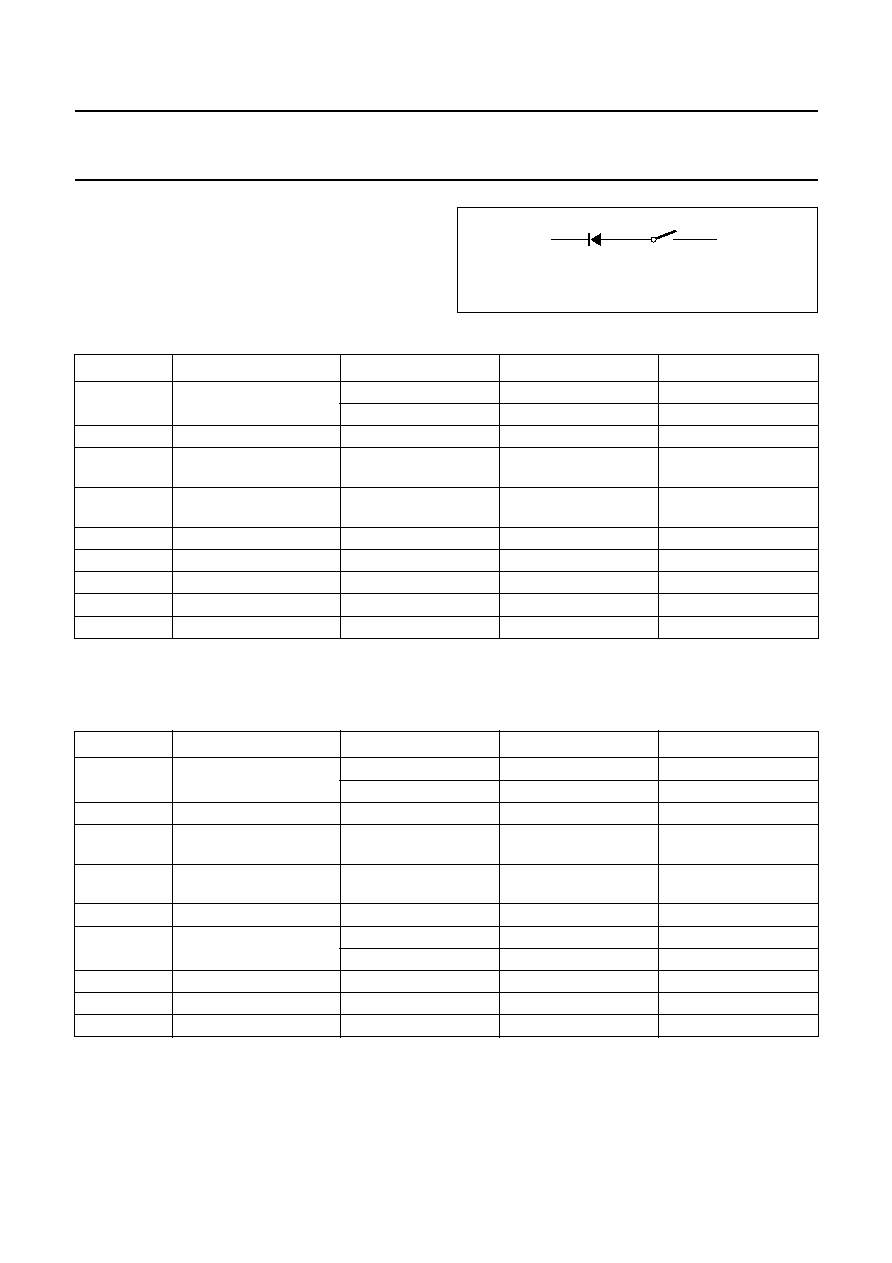
1998 Jan 08
21
Philips Semiconductors
Product specification
Versatile speech/dialler/ringer with
music-on-hold
TEA1069; TEA1069A
D
IODE OPTIONS
:
PIN
DIODE
The DIODE pin is connected to the keyboard matrix as
shown in Fig.20.
The diode options are read after each reset of the dialler.
Fig.20 Diode connection.
handbook, halfpage
MBH208
off
on
ROW/COLUMN
DIODE
Table 5
DIODE functions; TEA1069
Note
1. on means option diode present; off means option diode not present.
Table 6
DIODE functions; TEA1069A
Note
1. on means option diode present; off means option diode not present.
DIODE
FUNCTION
CONDITION
ON
(1)
OFF
(1)
FES A
flash/earth time select
FES B = off
flash of 270 ms
flash of 100 ms
FES B = on
earth of 400 ms
flash of 600 ms
TBT
tone burst/pause time
85/85 ms
100/100 ms
GOS
german output select
pin 8 = earth;
pin 27 = DMO
pin 8 = keytone;
pin 27 = MOH
KBS
keyboard select
keyboard layout;
see Figs 17 and 18
keyboard layout;
see Fig.19
PTS
pulse/tone selection
pulse mode
DTMF mode
APT
access pause time
APT2 = off
4 s
2 s
HMS
hold/mute select
hold mode
mute mode
RFS
ringer frequency select
29 to 146 Hz
40 to 120 Hz
M/B
make/break ratio
3 : 2
2 : 1
DIODE
FUNCTION
CONDITION
ON
(1)
OFF
(1)
FES A
flash/earth time select
FES B = off
flash of 270 ms
flash of 100 ms
FES B = on
earth of 400 ms
flash of 600 ms
TBT
tone burst/pause time
85/85 ms
100/100 ms
GOS
german output select
pin 8 = earth;
pin 27 = DMO
pin 8 = keytone;
pin 27 = MOH
KBS
keyboard select
keyboard layout;
see Fig.19
keyboard layout;
see Figs 17 and 18
PTS
pulse/tone selection
pulse mode
DTMF mode
APT
access pause time
APT2 = off
4 s
1 s
APT2 = on
3 s
2 s
HMS
hold/mute select
hold mode
mute mode
RFS
ringer frequency select
40 to 120 Hz
29 to 146 Hz
M/B
make/break ratio
3 : 2
2 : 1

1998 Jan 08
22
Philips Semiconductors
Product specification
Versatile speech/dialler/ringer with
music-on-hold
TEA1069; TEA1069A
K
EY TONE
:
PIN
KT/EARTH
Every time a valid key is pressed a keytone is generated
with a frequency of 606 Hz and a duration of 30 ms. This
function is selected by the diode GOS = off. KT/EARTH is
LOW when V
DD
is below power-on reset trip level and
when RESET is HIGH.
V
OLUME CONTROL
:
PINS
VOL1
AND
VOL2
Both pins can control the volume of the ringer and/or the
hands-free circuit. The state of VOL1/VOL2 is controlled
by a state machine as depicted in Fig.24.
VOL1 and VOL2 are push-pull outputs. Both are set LOW
when V
DD
is below power-on reset trip level and when
RESET is HIGH.
M
USIC
-
ON
-
HOLD
:
PIN
MOH/DMO
When the dialler is in the hold state (see Fig.23) a melody
is generated via pin TONE. In this state pin MOH/DMO can
be used via diode GOS = off as an enable signal for the
hardware to indicate that the tone should be switched to
the telephone line.
MOH/DMO is a push-pull output. It is set LOW when V
DD
is below power-on reset trip level and when RESET is
HIGH.
H
ANDS
-
FREE
:
PIN
HF
During the on-line state, the hands-free output pin HF is
used for enabling the hands-free hardware. The pin will
change state depending on specific key-sequences
(see Fig.23).
HF is a push-pull output. It is set LOW when V
DD
is below
power-on reset trip level and when RESET is HIGH.
HOLD
MODE
:
PIN
HOLD
One way to terminate the hold state (see Fig.23) is a
change in state of the signal at pin HOLD. This input
should reflect the line current. If current is flowing the
signal at pin HOLD should be HIGH, if not it should be
LOW.
This pin is not debounced. The signal applied should be
filtered by the hardware. HOLD is HIGH when V
DD
is below
power-on reset trip level and when RESET is HIGH.
Key sequences
The behaviour of the TEA1069 and TEA1069A can be
modelled as a State Transition Diagram (STD) shown in
Fig.21.
Fig.21 TEA1069 and TEA1069A dialler/ringer states.
handbook, full pagewidth
MBH209
STANDBY
power-on
ON-LINE
RINGER
on-hook/[HOOK]
off-hook/[HOOK]
off-hook/[HOOK]
ringer signal
ringer invalid
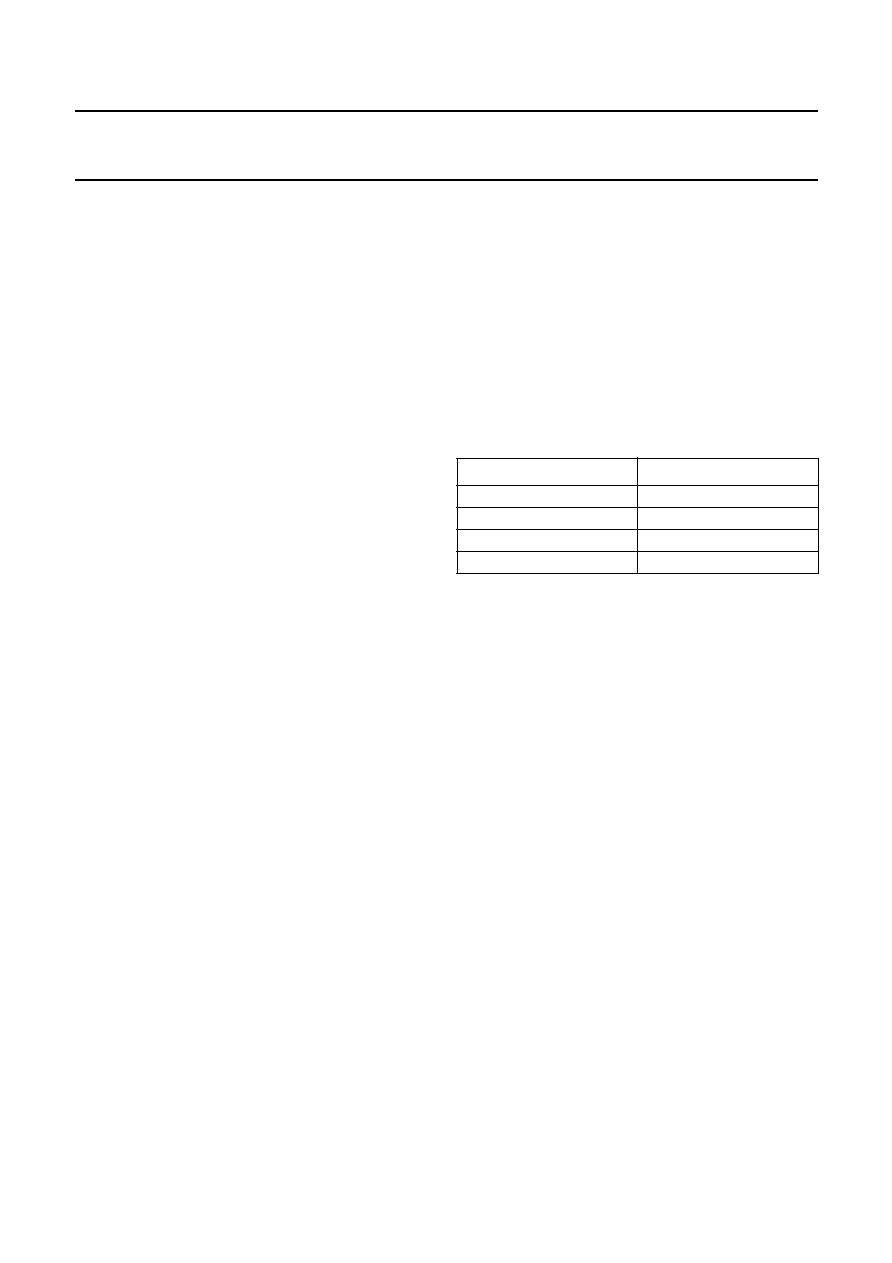
1998 Jan 08
23
Philips Semiconductors
Product specification
Versatile speech/dialler/ringer with
music-on-hold
TEA1069; TEA1069A
The STD contains the states (rectangles in the figure) and
state transitions (arrows) of the set. The upper arrow in the
figure pointing to the standby state means that the set is
initially in the standby state. When for instance an
incoming call is detected, the set enters the ringer state,
waiting for a reaction of the user. If the user answers the
call on a handset, the set enters the on-line state.
The TEA1069 and TEA1069A have 3 basic states:
∑
Standby state
∑
Ringer state
∑
On-line state.
Each state with its own functional requirements is
described in the following sections.
S
TANDBY STATE
In standby state the TEA1069 and TEA1069A are inactive.
The current drawn is for memory retention and depends on
the loads of the inputs/outputs of the dialler. In this state
output DP/FL is HIGH so that the line is disconnected.
The ICs leave the standby state if:
∑
The set goes off-hook (lift handset or press [HOOK])
∑
A ringer-signal is available on the line.
The ICs go to the standby state if:
∑
The set goes on-hook
(handset on the cradle or press [HOOK])
∑
A line-break occurs for at least the reset delay time (t
rd
)
∑
The ringer-signal becomes invalid.
R
INGER STATE
If the set is in standby mode, a ringer signal can be
received from the line. After evaluating the incoming ringer
signal (and ringer signal is valid), the TEA1069 and
TEA1069A start a melody via the TONE output ringer
hardware, and stops this melody if the ringer signal is not
valid any more. After going off-hook, the ringer signal stops
and the set is in conversation (on-line) state.
During a ringer burst the ringer volume can be changed
according to Fig.24 and melodies can be changed
according to Table 7.
Table 7
Melody selection
O
N
-
LINE STATE
In this paragraph all the actions of the TEA1069 and
TEA1069A during on-line state are described. The on-line
mode starts with making output DP/FL LOW, which makes
line current flow possible. The on-line state contains a
number of sub-states (see Fig.22):
∑
Conversation state
∑
Dialling state
∑
Memory recall state
∑
Program state.
MELODY
KEY
Bell 1
[1]
Bell 2
[2]
Bell 3
[3]
Bell 4
[4]

1998 Jan 08
24
Philips Semiconductors
Product specification
Versatile speech/dialler/ringer with
music-on-hold
TEA1069; TEA1069A
Conversation state
In this state conversation is possible. A number of sub-states (see Fig.23) exist:
∑
Handset state
∑
Hands-free state
∑
Hold state
∑
Mute state.
Depending on the diode option HMS the hold or the mute state is selected.
Fig.22 On-line states.
handbook, full pagewidth
MBH210
STANDBY
CONVERSATION
PROGRAM
DIALLING
MEMORY RECALL
[MRC] or [M1] to [M10]
[MRC] or [M1] to [M10]
on-hook/[HOOK]/line break
off-hook/[HOOK]
dial keys
end of recall
end
[STORE]
ON-LINE
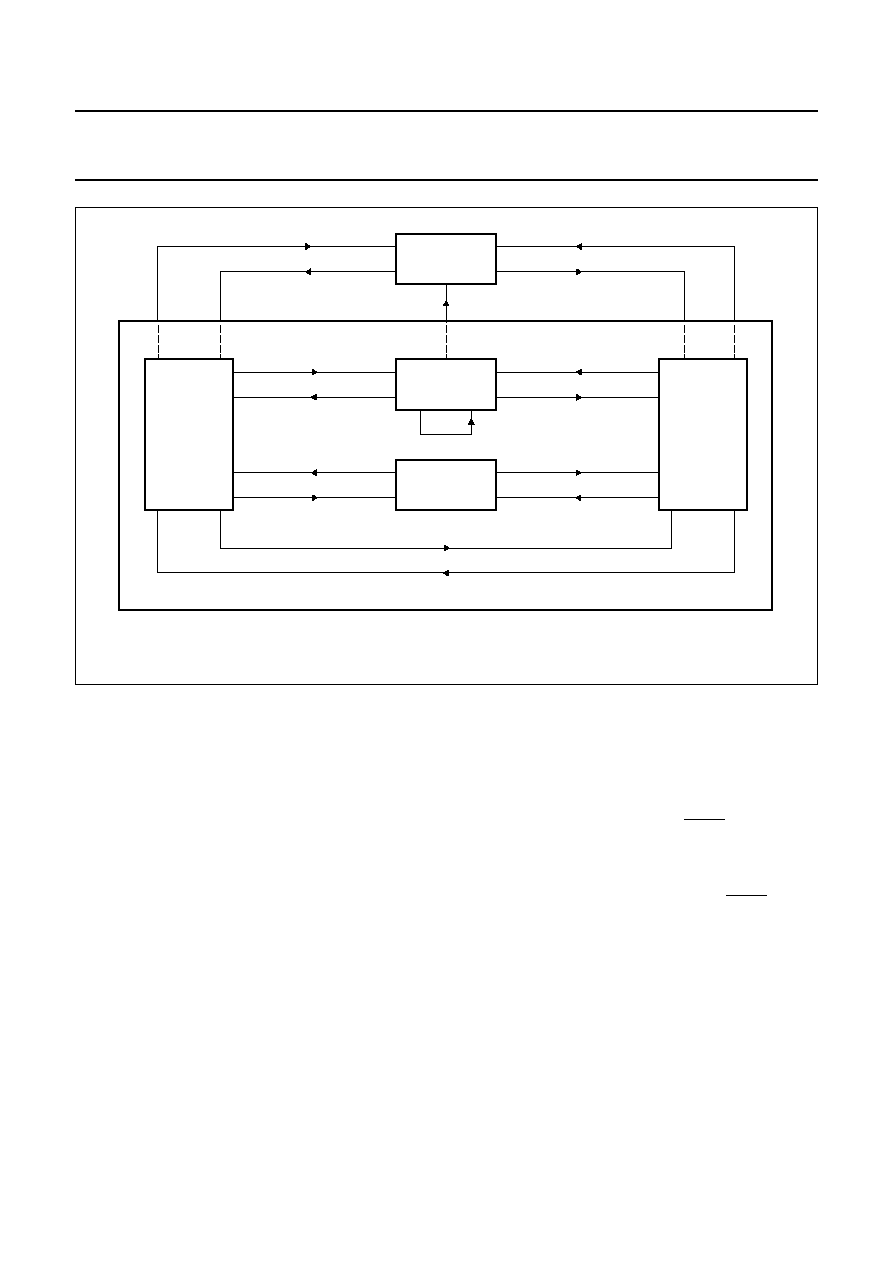
1998 Jan 08
25
Philips Semiconductors
Product specification
Versatile speech/dialler/ringer with
music-on-hold
TEA1069; TEA1069A
Fig.23 Conversation states.
handbook, full pagewidth
MBH211
STANDBY
HOLD
HANDSET
MUTE
HANDSFREE
[HOLD/MUTE]
+
HMS = off
[HOLD/MUTE]
+
HMS = on
[HOLD/MUTE]
+
HMS = on
[HOLD/MUTE]
[HOLD/MUTE]
+
HMS = off
[HOLD/MUTE]
[HOLD/MUTE]
[HOLD/MUTE]
[HOOK]
[HOOK]
+
on-hook
[HOOK]
[HOOK]
+
off-hook
on-hook
off-hook
on-hook
on-hook + pin HOLD = LOW
CONVERSATION
∑
Handset state.
The conversation states are shown in Fig.23.
∑
Hands-free state.
In hands-free mode output HF becomes HIGH which
activates a TEA1093/1094 hands-free IC. This state can
be reached from standby state and from the handset
state as follows:
≠ the [HOOK] key is pressed during standby mode
≠ the [HOOK] key is pressed during handset state is
lifted, then when the handset is put on the cradle the
set stays in the hands-free mode.
The set leaves the hands-free mode and output HF
becomes LOW when:
≠ the [HOOK] key is pressed and the handset is on the
cradle, the set goes to the standby mode
≠ the [HOOK] key is pressed and the handset is lifted,
the set goes to the handset state.
The volume on the loudspeaker or buzzer, in hands-free
and ringer mode, can be controlled in four levels using
the [VOL+] and [VOL
-
] keys.
The hands-free volume can be changed according to
Fig.24.
∑
Hold state.
The hold state is entered when the [HOLD/MUTE] key is
pressed (diode HMS = on). This state can be entered
either from handset state or from hands-free state. Upon
entering this state outputs HF and MUTE become LOW.
In hold state a music-on-hold melody is generated by
output TONE. Pin MOH/DMO is HIGH (diode
GOS = off) during this state. This signal can be used to
adjust the volume of the TONE pin. Since MUTE is LOW
the TONE output is transmitted to the telephone line.
As long as the TEA1069 and TEA1069A are in this state
the HOLD input pin is tested.
The set leaves the hold state when:
≠ [HOLD/MUTE] is pressed, the set returns to either the
handset or hands-free state
≠ the HOLD input becomes LOW, now the TEA1069
and TEA1069A return to the standby state.
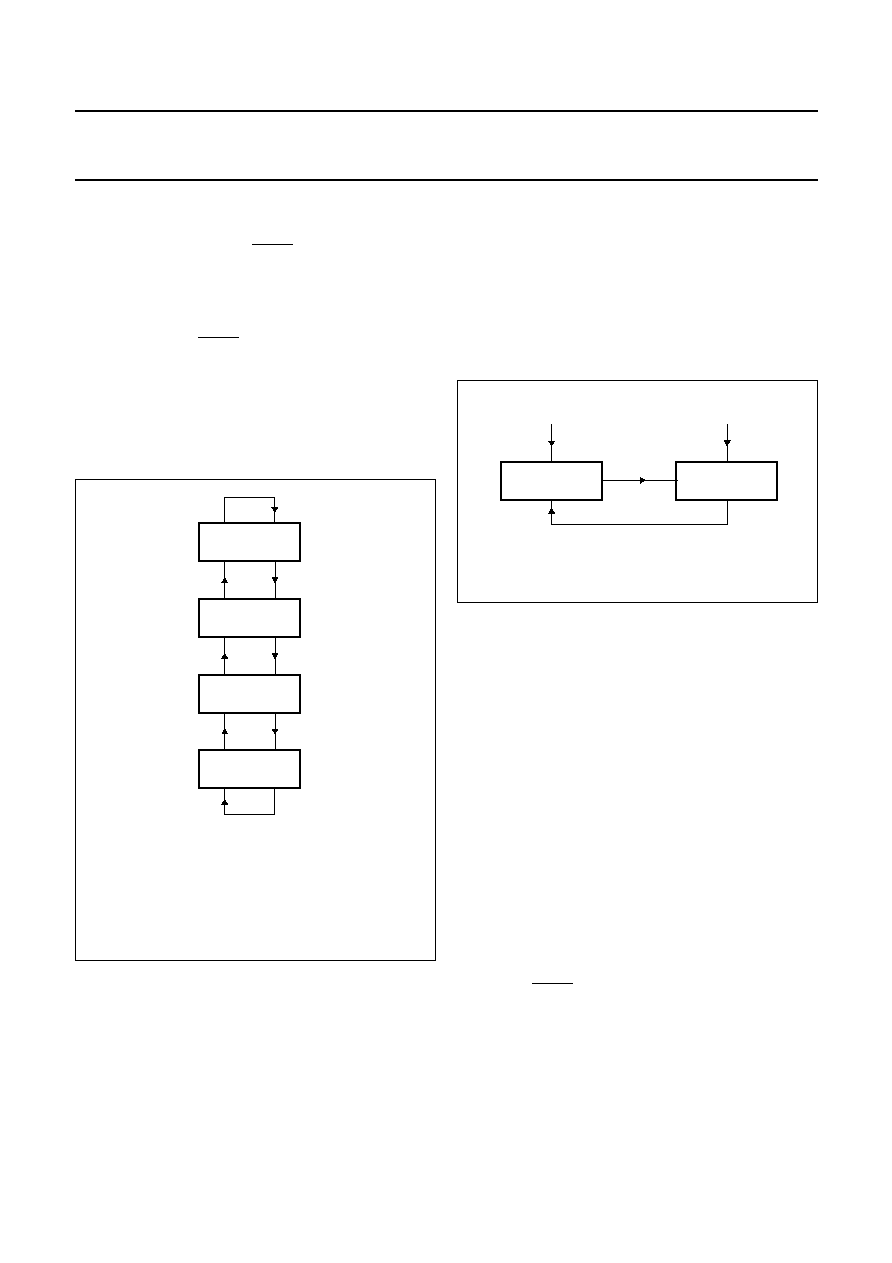
1998 Jan 08
26
Philips Semiconductors
Product specification
Versatile speech/dialler/ringer with
music-on-hold
TEA1069; TEA1069A
∑
Mute state.
When the [HOLD/MUTE] key is pressed (HMS = off) the
mute state is entered and MUTE becomes LOW.
In mute state a music-on-hold melody is generated by
output TONE. Pin MOH/DMO is HIGH (diode
GOS = off) during this state.
This signal can be used to adjust the volume of the
TONE pin. Since MUTE is LOW the TONE output is
transmitted to the telephone line. The mute state is left
when:
≠ [HOLD/MUTE] is pressed, set returns to either
handset- or hands-free state
≠ a dial action is started.
Dialling state
During the dial-keys entries the TEA1069 and TEA1069A
start immediately with transmission of the digit(s); the
minimum transmission time is unaffected by the speed of
the entry. Transmission continues as long as further
dial-keys entries have to be processed.
Fig.24 Volume control state machine.
(1) VOL1 = HIGH, VOL2 = HIGH.
(2) VOL1 = LOW, VOL2 = HIGH.
(3) VOL1 = HIGH, VOL2 = LOW.
(4) VOL1 = LOW, VOL2 = LOW.
handbook, halfpage
MBH212
HIGHEST
HIGH
[VOL
-
]
[VOL
+
]
LOW
[VOL
-
]
[
VOL
+
]
LOWEST
[VOL
-
]
[VOL
-
]
[VOL
+
]
[VOL
+
]
(4)
(3)
(2)
(1)
However when keying-in is much faster then dialling-out,
then the 32 digit dialling register will overflow. When this
occurs the dialling is stopped and the error beep will be
generated.
There are two dial modes: pulse dialling and tone dialling.
The initial dialling mode is determined by option PTS.
The state machine which controls the dial mode is shown
in Fig.25.
∑
Pulse dialling.
In this mode all valid keys are dialled by the pulse dialler.
When during pulse dialling key [
/T] is pressed, the
TEA1069 and TEA1069A switch over to tone dialling
(mixed mode dialling). After the switch-over, valid keys
are dialled by the tone dialler. The temporary tone mode
is terminated by going on-hook or recall.
∑
Tone dialling.
The ICs convert valid keys into data for the on-chip
DTMF generator. Tones are transmitted via output
TONE with minimum tone burst/pause duration.
The maximum tone burst/pause duration is equal to the
key pressing/release time.
∑
Register recall (flash/earth).
The [RECALL] key will result in a flash or earth action.
∑
Access pause.
When the [PAUSE/LNR] button is not the first key
pressed, an access pause is entered for repertory or
redialling procedures. When an access pause is
executed MUTE is HIGH. During manual dialling no
access pauses are dialled.
∑
Last Number Redial (LNR).
If the first key pressed is the [PAUSE/LNR] button, the
number stored in the redial register is recalled and
transmitted. A maximum number of 32 digits can be
Fig.25 Dialling mode state machine.
handbook, halfpage
MBH213
PULSE DIALLING
PTS = on
PTS = off
TONE DIALLING
[
*
/T
]
[
RECALL
]
+
PTS = on

1998 Jan 08
27
Philips Semiconductors
Product specification
Versatile speech/dialler/ringer with
music-on-hold
TEA1069; TEA1069A
accepted for last number redial. If this maximum is
reached the redial function is inhibited. During LNR
programmed access pauses are also dialled.
The [RECALL] key and the (in pulse dialling mode
allowed) tone switch key [
/T] are also stored in LNR
memory.
∑
Notepad function.
In conversation state it is possible to store a number into
the LNR register, which may be dialled after an
on-hook/off-hook action. The procedure is as follows:
≠ press [STORE]
≠ press to-be-stored sequence of the digits [0] to [9],
[PAUSE/LNR], [
/T] or [RECALL]
≠ press [STORE]
≠ press [PAUSE/LNR].
Memory recall state
Repertory numbers can be dialled-out after or before
entering manual dialling, last number redial and by
entering the memory locations in successive order.
The stored numbers can be dialled by the following
procedures:
∑
Press [MRC]
∑
Press one of the numeric keys [0] to [9], corresponding
to the memory location
or
∑
Press one of the direct memory keys ([M1] to [M10]).
Program state
The program mode can be entered from the conversation
(on-line) mode.
Pressing the [STORE] key in this state puts the TEA1069
and TEA1069A in the program mode. The program state
can be left by going on-hook (by putting the handset on the
cradle or pressing the [HOOK] key), the program mode is
interrupted and nothing is stored, or by ending the store
procedures resulting in a proper store of the programmed
item.
∑
Programming repertory numbers.
Storing of a new repertory number including access
pauses, tone switch and register recall can be done by
the following procedures:
≠ press [STORE]
≠ press to-be-stored sequence of the digits [0] to [9],
[PAUSE/LNR], [
/T] or [RECALL]
≠ press [MRC]
≠ press one of the numeric keys [0] to [9],
corresponding to the memory location
or
≠ press [STORE]
≠ press to-be-stored sequence of the digits [0] to [9],
[PAUSE/LNR], [
/T] or [RECALL]
≠ press [M1] to [M10].
For storing the redial number in repertory use:
≠ press [STORE]
≠ press [PAUSE/LNR]
≠ press [MRC]
≠ press one of the numeric keys [0] to [9],
corresponding to the memory location
or
≠ press [STORE]
≠ press [PAUSE/LNR]
≠ press [M1] to [M10].
If the keyboard described in Fig.17 is selected by the
KBS diode option, repertory memory place
[M1] = [MRC] + [1] to [M10] = [MRC] + [0], thus the set
has 10 repertory numbers which can be selected via two
different ways.
If the keyboard described in Fig.19 is selected by the
KBS diode option repertory memory place
[MRC] + [0] to [MRC] + [9] and [M1], [M2] and [M3] are
different repertory numbers, thus this set has in total
13 repertory numbers.
∑
Memory overflow.
A maximum of 224 digits can be stored in the repertory
memories. When the maximum is reached, no keytone
is generated when trying to store more digits. The store
procedure is cancelled automatically.
∑
Clear repertory number.
Clearing a memory location is possible via the same
procedure as for storing a number, except no telephone
number is entered, thus one of the following sequences
must be used:
≠ press [STORE]
≠ press [MRC]
≠ press one of the numeric keys [0] to [9],
corresponding to the memory location
or
≠ press [STORE]
≠ press [M1] to [M10].

1998 Jan 08
28
Philips Semiconductors
Product specification
Versatile speech/dialler/ringer with
music-on-hold
TEA1069; TEA1069A
LIMITING VALUES
In accordance with the Absolute Maximum Rating System (IEC 134).
Notes
1. Mostly dependent on the maximum required T
amb
and on the voltage between LN and SLPE (see Fig.26 for
TEA1069N or Fig.27 for TEA1069H and TEA1069AH).
2. Calculated for the maximum specified ambient temperature (T
amb
= 70
∞
C, see also Fig.26 for TEA1069N or Fig.27
for TEA1069H and TEA1069AH).
THERMAL CHARACTERISTICS
SYMBOL
PARAMETER
CONDITIONS
MIN.
MAX.
UNIT
I
line
line current
R9 = 20
; note 1
-
140
mA
I
EE
ground supply current through V
EE
-
50
mA
P
tot
total power dissipation
R9 = 20
; note 2
TEA1069N
-
770
mW
TEA1069H and TEA1069AH
-
300
mW
T
amb
operating ambient temperature
-
25
+70
∞
C
T
stg
IC storage temperature
-
40
+125
∞
C
Speech part
V
LN
positive continuous line voltage
-
12
V
V
LN(R)
repetitive line voltage during switch-on or line
interruption
-
13.2
V
V
CC
input voltage on pin V
CC
-
12
V
V
i
input voltage on pins 1 to 7, 37, 38, 39, 41, 42
V
EE
-
0.7
V
CC
+ 0.7 V
Dialler/ringer part
V
DD
supply voltage
-
0.7
+7
V
V
i
input voltages on pins 8 to 22, 24, 26 to 35
V
EE
-
0.7
V
DD
+ 0.7 V
I
I
DC input current on pins 8 to 22, 24, 26 to 35
-
10
+10
mA
I
O
DC output current on pins 8 to 22, 24, 26 to 35
-
10
+10
mA
P
o
power dissipation per output on pins 8 to 22,
24, 26 to 35
-
30
mW
SYMBOL
PARAMETER
VALUE
UNIT
R
th j-a
thermal resistance from junction to ambient in free air mounted on
glass epoxy board 28.5
◊
19.1
◊
1.5 mm
TEA1069N
63
K/W
TEA1069H and TEA1069AH
116
K/W
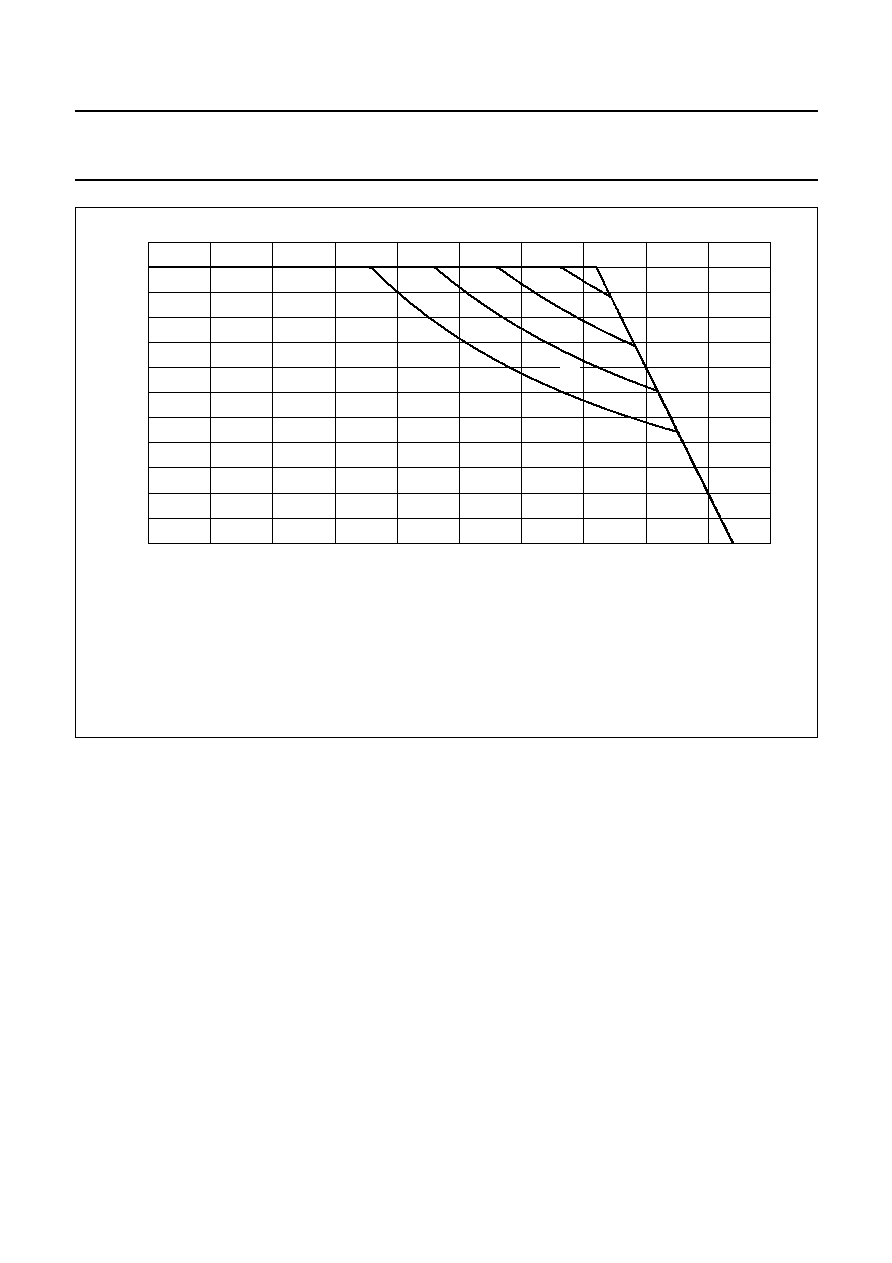
1998 Jan 08
29
Philips Semiconductors
Product specification
Versatile speech/dialler/ringer with
music-on-hold
TEA1069; TEA1069A
(1) T
amb
= 40
∞
C; P
tot
= 1200 mW.
(2) T
amb
= 50
∞
C; P
tot
= 1050 mW.
(3) T
amb
= 60
∞
C; P
tot
= 910 mW.
(4) T
amb
= 70
∞
C; P
tot
= 770 mW.
Fig.26 TEA1069N safe operating area.
Note: calculations based upon negligible dialler and ringer parts output power (null port sink current).
handbook, full pagewidth
12
11
VLN
-
VSLPE (V)
150
Iline
(mA)
30
2
3
4
5
6
(2)
7
8
9
10
MGD376
110
70
50
130
90
(1)
(4)
(3)

1998 Jan 08
30
Philips Semiconductors
Product specification
Versatile speech/dialler/ringer with
music-on-hold
TEA1069; TEA1069A
(1) T
amb
= 40
∞
C; P
tot
= 665 mW.
(2) T
amb
= 50
∞
C; P
tot
= 590 mW.
(3) T
amb
= 60
∞
C; P
tot
= 460 mW.
(4) T
amb
= 70
∞
C; P
tot
= 300 mW.
Fig.27 TEA1069H and TEA1069AH safe operating area.
Note: calculations based upon negligible dialler and ringer parts output power (null port sink current).
handbook, full pagewidth
12
11
VLN
-
VSLPE (V)
160
140
Iline
(mA)
20
2
3
4
5
6
(2)
7
8
9
10
MBH785
100
60
40
120
80
(1)
(4)
(3)

1998 Jan 08
31
Philips Semiconductors
Product specification
Versatile speech/dialler/ringer with
music-on-hold
TEA1069; TEA1069A
CHARACTERISTICS
I
line
= 11 to 140 mA; V
EE
= 0 V; f = 1 kHz; V
DD
= 3 V; f
xtal
= 3.579545 MHz; T
amb
= 25
∞
C; unless otherwise specified.
SYMBOL
PARAMETER
CONDITIONS
MIN.
TYP.
MAX.
UNIT
Speech part
S
UPPLIES
LN
AND
V
CC
(
PINS
40
AND
36)
V
LN
voltage drop over circuit between
LN and V
EE
MIC inputs open-circuit
I
line
= 1 mA
-
1.6
-
V
I
line
= 4 mA
-
1.9
-
V
I
line
= 15 mA
3.55
4.0
4.25
V
I
line
= 100 mA
4.9
5.7
6.5
V
I
line
= 140 mA
-
-
7.5
V
V
LN
/
T
variation with temperature
I
line
= 15 mA
-
-
0.3
-
mV/K
V
LN
voltage drop over circuit between
LN and V
EE
with external resistor
R
VA
I
line
= 15 mA
R
VA
(LN to REG) = 68 k
-
3.5
-
V
R
VA
(REG to SLPE) = 39 k
-
4.5
-
V
I
CC
supply current
V
CC
= 2.8 V
-
0.9
1.35
mA
V
CC
supply voltage available for
peripheral circuitry
I
line
= 15 mA; MUTE = LOW
I
p
= 1.2 mA
2.2
2.7
-
V
I
p
= 0 mA
-
3.4
-
V
M
ICROPHONE INPUTS
MIC
-
AND
MIC+ (
PINS
3
AND
4)
Z
i
input impedance
differential
between MIC
-
and MIC+
-
64
-
k
single-ended
MIC
-
or MIC+ to V
EE
-
32
-
k
CMRR
common mode rejection ratio
-
82
-
dB
G
v
voltage gain MIC+ or MIC
-
to LN
I
line
= 15 mA; R7 = 68 k
50.5
52.0
53.5
dB
G
v(f)
gain variation with frequency
referenced to 800 Hz
f = 300 and 3400 Hz
-
±
0.2
-
dB
G
v(T)
gain variation with temperature
referenced to 25
∞
C
without R6; I
line
= 50 mA;
T
amb
=
-
25 to +70
∞
C
-
±
0.2
-
dB
DTMF
INPUT
(
PIN
7)
Z
i
input impedance
-
20.7
-
k
G
v
voltage gain from DTMF to LN
I
line
= 15 mA; R7 = 68 k
24.0
25.5
27.0
dB
G
v(f)
gain variation with frequency
referenced to 800 Hz
f = 300 and 3400 Hz
-
±
0.2
-
dB
G
v(T)
gain variation with temperature
referenced to 25
∞
C
I
line
= 50 mA;
T
amb
=
-
25 to +70
∞
C
-
±
0.2
-
dB
G
AIN ADJUSTMENT INPUTS
GAS1
AND
GAS2 (
PINS
41
AND
42)
G
v
transmitting amplifier gain
variation by adjustment of R7
between GAS1and GAS2
-
8
-
0
dB

1998 Jan 08
32
Philips Semiconductors
Product specification
Versatile speech/dialler/ringer with
music-on-hold
TEA1069; TEA1069A
S
ENDING AMPLIFIER OUTPUT
LN (
PIN
40)
V
LN(rms)
output voltage (RMS value)
THD = 10%
I
line
= 4 mA
-
0.8
-
V
I
line
= 15 mA
1.7
2.3
-
V
V
no(rms)
noise output voltage (RMS value) I
line
= 15 mA; R7 = 68 k
;
200
between MIC
-
and
MIC+; psophometrically
weighted (P53 curve)
-
-
69
-
dBmp
R
ECEIVING AMPLIFIER INPUT
IR (
PIN
6)
Z
i
input impedance
-
21
-
k
R
ECEIVING AMPLIFIER OUTPUT
QR (
PIN
1)
Z
o
output impedance
-
4
-
G
v
voltage gain from IR to QR
I
line
= 15 mA; R
L
= 300
(from pin 9 to pin 4)
29.5
31
32.5
dB
G
v(f)
gain variation with frequency
referenced to 800 Hz
f = 300 and 3400 Hz
-
±
0.2
-
dB
G
v(T)
gain variation with temperature
referenced to 25
∞
C
without R6; I
line
= 50 mA;
T
amb
=
-
25 and +70
∞
C
-
±
0.2
-
dB
V
o(rms)
output voltage (RMS value)
THD = 2%; sine wave drive;
R4 = 100 k
; I
line
= 15 mA;
I
p
= 0 mA
R
L
= 150
0.22
0.33
-
V
R
L
= 450
0.3
0.48
-
V
THD = 10%; R4 = 100 k
;
R
L
= 150
; I
line
= 4 mA
-
15
-
mV
V
no(rms)
noise output voltage (RMS value) I
line
= 15 mA; R4 = 100 k
;
IR open-circuit
psophometrically weighted
(P53 curve); R
L
= 300
-
50
-
µ
V
G
AIN ADJUSTMENT INPUT
GAR (
PIN
2)
G
v
receiving amplifier gain variation
by adjustment of R4 between
GAR and QR
-
11
-
0
dB
MUTE (
PIN
35)
GAIN REDUCTION
G
v
MIC+ or MIC
-
to LN
MUTE = LOW
-
70
-
dB
G
v
voltage gain from DTMF to QR
R4 = 100 k
; R
L
= 300
-
-
17
-
dB
SYMBOL
PARAMETER
CONDITIONS
MIN.
TYP.
MAX.
UNIT

1998 Jan 08
33
Philips Semiconductors
Product specification
Versatile speech/dialler/ringer with
music-on-hold
TEA1069; TEA1069A
A
UTOMATIC GAIN CONTROL INPUT
AGC (
PIN
38)
G
v
gain control range (controlling the
gain from IR to QR and the gain
from MIC+, MIC
-
to LN)
R6 = 110 k
(between AGC and V
EE
);
I
line
= 70 mA
-
-
5.8
-
dB
I
lineH
highest line current for maximum
gain
R6 = 110 k
-
23
-
mA
I
lineL
lowest line current for minimum
gain
R6 = 110 k
-
61
-
mA
Dialler part
V
DD
(
PIN
25)
V
DD
supply voltage
2.5
-
6.0
V
V
DD(MR)
memory retention voltage
1.0
-
6.0
V
I
DD
supply current
DTMF generator off
-
0.3
0.6
mA
DTMF generator on
-
0.9
1.8
mA
I
DD(MR)
memory retention current
standby state, V
DD
= 1.8 V
-
1.2
-
µ
A
V
POR
power-on reset trip level
1.5
2.0
2.5
V
I
NPUTS
/
OUTPUTS
(
PINS
9, 12
TO
21, 29
TO
34)
V
IL
LOW level input voltage
0
-
0.3V
DD
V
V
IH
HIGH level input voltage
0.7V
DD
-
V
DD
V
I
IL
input leakage
V
EE
< V
I
< V
DD
-
1
-
+1
µ
A
I
OL
port sink current LOW
V
DD
= 3 V; V
O
= 0.4 V
0.7
8
-
mA
I
OH
port pull-up source current HIGH
(not valid for pin 33)
V
DD
= 3 V; V
O
= 2.7 V
10
20
-
µ
A
V
DD
= 3 V; V
O
= 0 V
-
100
300
µ
A
MUTE (
PIN
35)
I
OL
port sink current LOW
V
DD
= 3 V; V
O
= 0.4 V
0.7
8
-
mA
O
UTPUTS
(
PINS
8, 22, 26
TO
28)
I
OL
port sink current LOW
V
DD
= 3 V; V
O
= 0.4 V
0.7
8
-
mA
I
OH
port push-pull source current
HIGH
V
DD
= 3 V; V
O
= 2.6 V
0.7
4
-
mA
O
SCILLATOR
(
PINS
10
AND
11)
g
m
transconductance
0.2
0.4
1.0
mA/V
R
f
feedback resistor
0.3
1.0
3.0
M
CE/FDI (
PIN
13)
t
rd
reset delay time
-
280
-
ms
SYMBOL
PARAMETER
CONDITIONS
MIN.
TYP.
MAX.
UNIT

1998 Jan 08
34
Philips Semiconductors
Product specification
Versatile speech/dialler/ringer with
music-on-hold
TEA1069; TEA1069A
K
EYBOARD
(
PINS
14
TO
19
AND
29
TO
33)
t
d
keyboard debounce time
-
20
-
ms
t
ap
access pause time
TEA1069
diodes APT off; APT2 off
-
2
-
s
diodes APT on; APT2 off
-
4
-
s
TEA1069A
diodes APT off; APT2 off
-
1
-
s
diodes APT on; APT2 off
-
4
-
s
diodes APT off; APT2 on
-
2
-
s
diodes APT on; APT2 on
-
3
-
s
DP/FL
OUTPUT
(
PIN
20)
t
idp
interdigit pause time
-
840
-
ms
t
holdover
mute hold-over time
-
40
-
ms
t
interflash
interflash hold-over time
TEA1069
-
0
-
ms
TEA1069A
-
960
-
ms
t
m
make time
diode M/B off
-
40
-
ms
diode M/B on
-
33
-
ms
t
b
break time
diode M/B off
-
60
-
ms
diode M/B on
-
66
-
ms
t
rc
recall time using flash
diode FES A off, FES B off
-
100
-
ms
diode FES A on, FES B off
-
270
-
ms
diode FES A off, FES B on
-
600
-
ms
t
ea
recall time using earth
diode FES A on, FES B on
-
400
-
ms
T
ONE OUTPUT
(
PIN
24)
t
t
burst time
diode TBT off
-
100
-
ms
diode TBT on
-
85
-
ms
t
p
pause time
diode TBT off
-
100
-
ms
diode TBT on
-
85
-
ms
f/f
frequency deviation
-
0.6
+0.6
%
V
HG(rms)
HGF voltage (RMS value)
158
181
205
mV
V
LG(rms)
LGF voltage (RMS value)
125
142
160
mV
V
DC
DC voltage level
-
1
/
2
V
DD
-
V
Z
o
output impedance
-
100
500
V
G
pre-emphasis of group
1.5
2.0
2.5
dB
THD
total harmonic distortion
-
-
25
-
dB
SYMBOL
PARAMETER
CONDITIONS
MIN.
TYP.
MAX.
UNIT
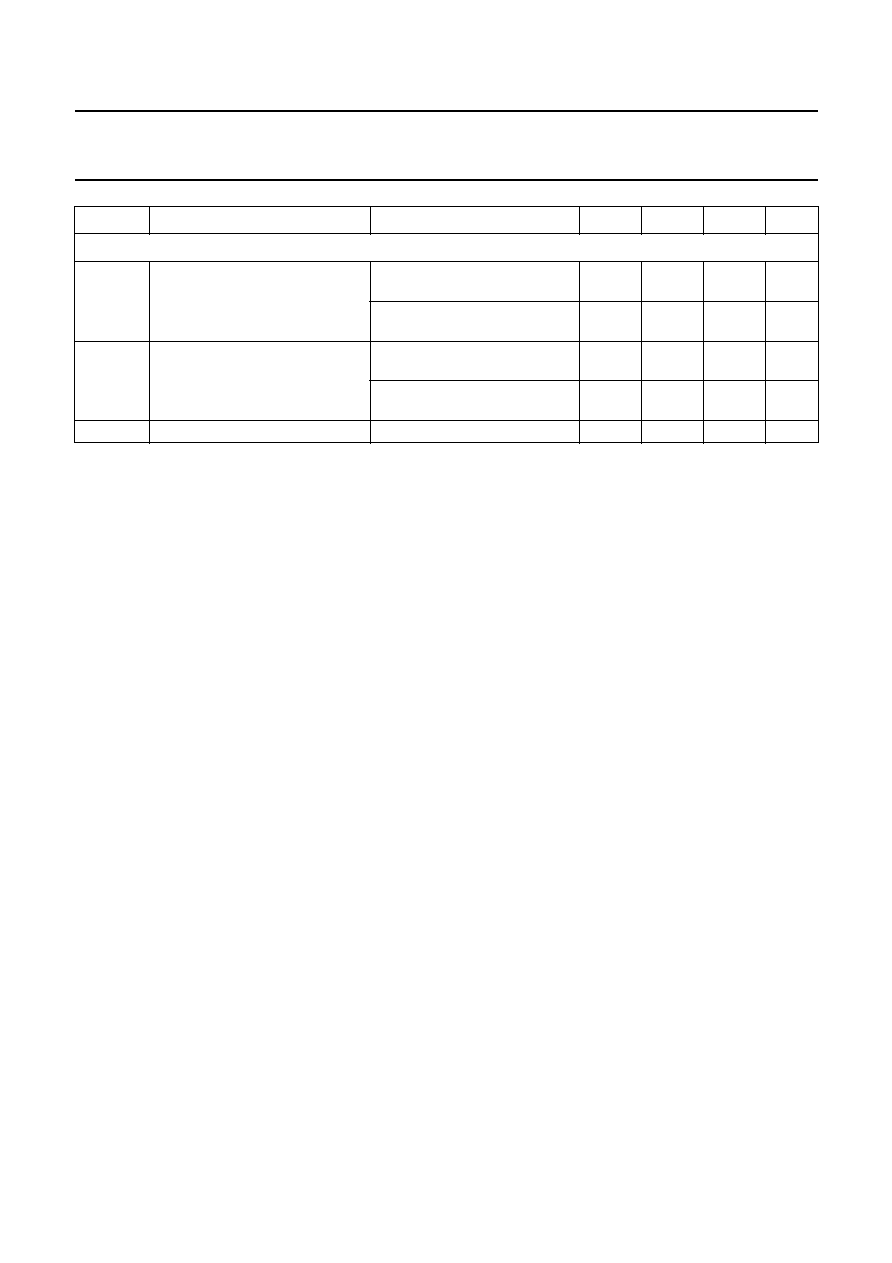
1998 Jan 08
35
Philips Semiconductors
Product specification
Versatile speech/dialler/ringer with
music-on-hold
TEA1069; TEA1069A
Ringer part
f
ringL
ringer detection LOW frequency
diode RFS off (TEA1069);
diode RFS on (TEA1069A)
-
40
-
Hz
diode RFS on (TEA1069);
diode RFS off (TEA1069A)
-
29
-
Hz
f
ringH
ringer detection HIGH frequency
diode RFS off (TEA1069);
diode RFS on (TEA1069A)
-
120
-
Hz
diode RFS on (TEA1069);
diode RFS off (TEA1069A)
-
146
-
Hz
t
rrd
ringer response delay
<1.5 frequency cycle
-
-
150
ms
SYMBOL
PARAMETER
CONDITIONS
MIN.
TYP.
MAX.
UNIT

1998 Jan 08
36
Philips Semiconductors
Product specification
Versatile speech/dialler/ringer with
music-on-hold
TEA1069; TEA1069A
APPLICATION INFORMATION
Fig.28 Basic application diagram (continued in Fig.29).
Pin numbers in parenthesis refer to the TEA1069H and TEA1069AH.
(1) Ringer supply voltage.
handbook, full pagewidth
BSP254A
TR1
C20
1 nF
BZX79C
(10 V)
Z2
Z1
BZX79C
(8.2 V)
TR2
BC558
R20
3.9
R22
470 k
R23
470 k
R21
470 k
R2
130
k
R3
3.92 k
R11
130
R9
20
R7
27.4
k
R61
100
k
40 (36)
(1)
R24
TR3
BF420
TR4
BC548C
2.2 M
LN
6 (44)
IR
42 (38)
GAS2
41 (37)
GAS1
39 (35)
DP/FL
SLPE
37 (33)
REG
23 (11, 18 and 23)
VEE
VDD
LN
C5
C16
C6
100 pF
J1
C17
33 nF
100 pF
R8
C3
390
1 nF
R60
100
k
C12
220
nF
C40
2.2 nF
R30
2.2 k
C30
1
µ
F
(250 V)
C31
22
µ
F
(35 V)
D1
BR211_220
D2
BAS11
D3
BAS11
D4
BAS11
D5
BAS11
D10
1N4148
C32
33 nF
X1
3.58 MHz
D8
1N4148
D9
1N4148
D7
1N4148
D6
1N4148
Z3
BZX79C
(18 V)
4.7
µ
F
(63 V)
R12
820
R40
470 k
470 k
R42
C41
2.2
µ
F
(63 V)
R41
100 k
R32
100 k
Z4
BZX79C
(18 V)
R35
18 k
R33
100 k
R34
1 k
TR5
BC546
J4
H1
40 V (p-p)
TR6
BC556
TR7
BC548
R43
470
k
R44
56 k
VDD
9 (3)
CSI
13 (7)
CE/FDI
10 (4)
XTAL1
11 (5)
XTAL2
12 (6)
RESET
35 (31)
MUTE
28 (24)
HF
VCC
Vrr
TONE
26 (21)
VOL1
22 (17)
VOL2
27 (22)
MOH/DMO
MOH/DMO
21 (16)
HOLD
8 (2)
KT/EARTH
TEA1069
R1a
619
R1b
C1b
R31
5.6 M
S1-2
S1-1
speech
ring
A
-
B/B
-
A
MBH214
A

1998 Jan 08
37
Philips Semiconductors
Product specification
Versatile speech/dialler/ringer with
music-on-hold
TEA1069; TEA1069A
Fig.29 Basic application diagram (continued from Fig.28).
Pin numbers in parenthesis refer to the TEA1069H and TEA1069AH.
(1) Ringer supply voltage.
(2) Only on TEA1069A.
handbook, full pagewidth
MBH215
BZX79C
(5.6 V)
BZX79C (18 V)
Z5
Z6
(32) 36
C42
470
µ
F
(10 V)
VCC
(8) 14
COL6
(9) 15
COL5
(10) 16
COL4
(12) 17
COL3
(13) 18
COL2
(14) 19
COL1
(29) 33
ROW5
(28) 32
ROW4
(27) 31
ROW3
(26) 30
ROW2
(25) 29
ROW1
(30) 34
DIODE
COL6
COL5
COL4
COL3
COL2
COL1
ROW5
ROW4
ROW3
ROW2
ROW1
DIODE
(20) 25
(1) 7
VDD
VDD
(15) 20
DP/FL
DP/FL
(19) 24
TONE
DTMF
TONE
(1)
TEA1069
C44
100 nF
C14
100 nF
R45
10 k
R46
3.65 k
R4
68.1
k
R14
8.2 k
R16
100
D11
BAT85
C4
560 pF
C7 5.6 nF
C2 10
µ
F
(63 V)
C15 47
µ
F
(25 V)
C1
100
µ
F
(25 V)
TR8
BC548
R47 330
47 k
R48
R17
100
MOH
R6 110 k
(34) 38
AGC
R5 3.65 k
(43) 5
STAB
(40) 2
GAR
C19
150 nF
R15
2.21 k
150 nF
C18
R13
2.21 k
R10
3.32
k
22.1 k
R49
(39) 1
QR
(42) 4
MIC
+
(41) 3
MIC
-
VCC
VDD
Vrr
STORE
S13
M1
S14
M2
S15
3
S12
2
S11
1
S10
MRC
S19
M3
S20
6
S18
5
S17
4
S16
9
S24
8
S23
7
S22
#
S29
0
S28
*
/T
S27
MUTE
S34
PAUSE/LNR
S33
RECALL
S32
D15
1N4148
D24
1N4148
D16
1N4148
D17
1N4148
D18
1N4148
D23
1N4148
D22
1N4148
D21
1N4148
D20
1N4148
D19
1N4148
D14
1N4148
R50
680 k
ROW5
ROW4
ROW3
ROW2
ROW1
COL1
COL2
COL3
COL4
COL5
COL6
VDD
1
S2
DIODE
FES A
2
FES B
3
TBT
4
GOS
5
KBS
6
PTS
APT
7
8
HMS
9
RFS
10
M/B
11
APT2
(2)
A
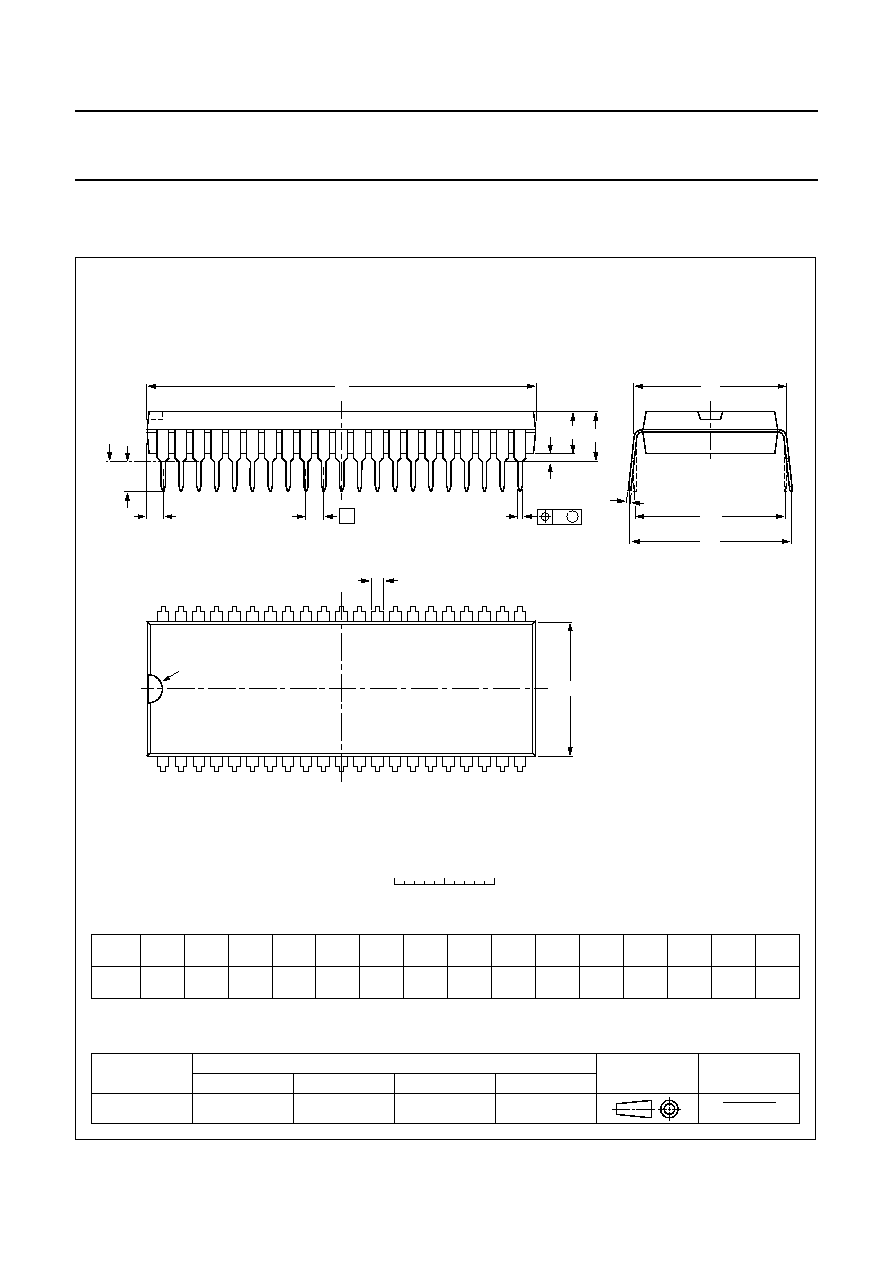
1998 Jan 08
38
Philips Semiconductors
Product specification
Versatile speech/dialler/ringer with
music-on-hold
TEA1069; TEA1069A
PACKAGE OUTLINES
UNIT
b
1
c
E
e
M
H
L
REFERENCES
OUTLINE
VERSION
EUROPEAN
PROJECTION
ISSUE DATE
IEC
JEDEC
EIAJ
mm
DIMENSIONS (mm are the original dimensions)
SOT270-1
90-02-13
95-02-04
b
max.
w
M
E
e
1
1.3
0.8
0.53
0.40
0.32
0.23
38.9
38.4
14.0
13.7
3.2
2.9
0.18
1.778
15.24
15.80
15.24
17.15
15.90
1.73
5.08
0.51
4.0
M
H
c
(e )
1
M
E
A
L
seating plane
A
1
w
M
b
1
e
D
A
2
Z
42
1
22
21
b
E
pin 1 index
0
5
10 mm
scale
Note
1. Plastic or metal protrusions of 0.25 mm maximum per side are not included.
(1)
(1)
D
(1)
Z
A
max.
1
2
A
min.
A
max.
SDIP42: plastic shrink dual in-line package; 42 leads (600 mil)
SOT270-1
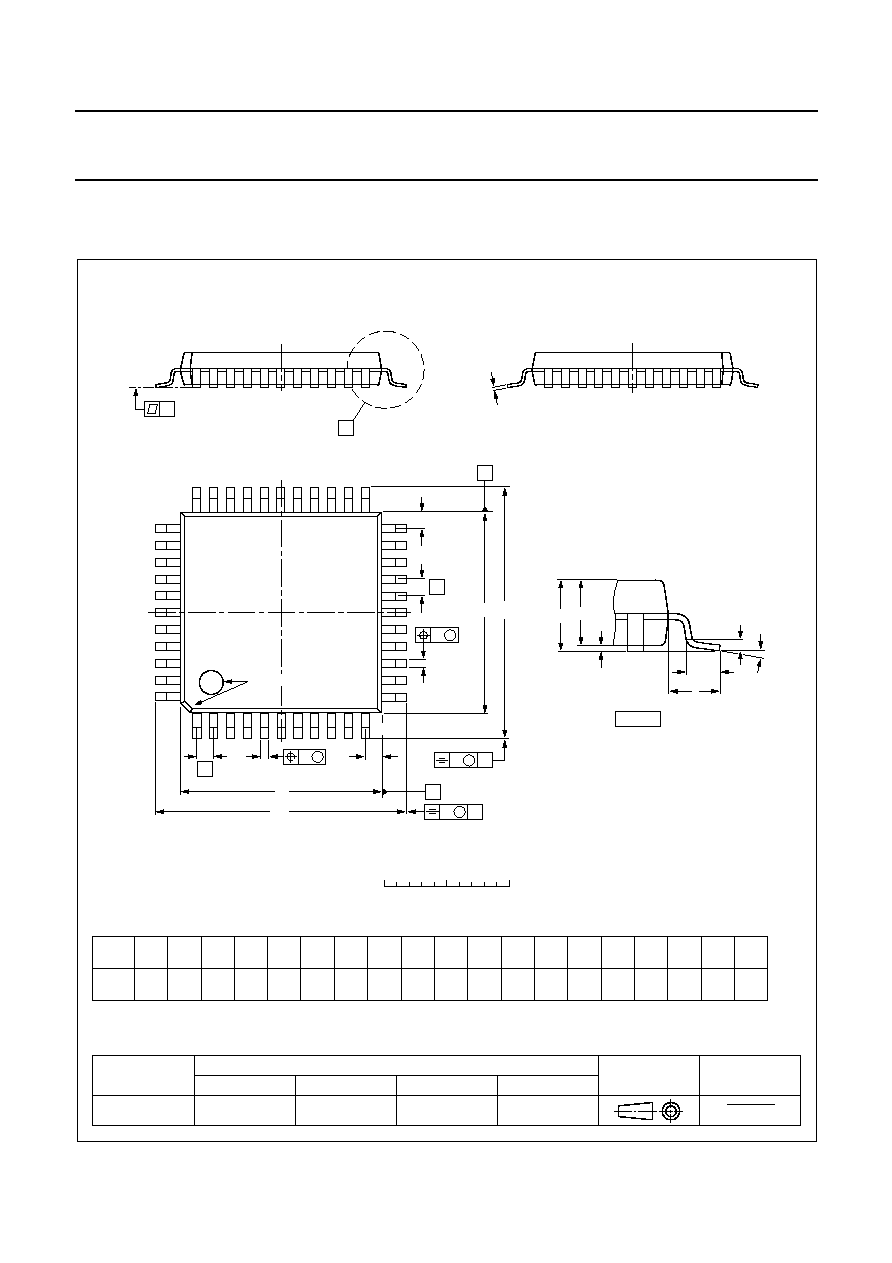
1998 Jan 08
39
Philips Semiconductors
Product specification
Versatile speech/dialler/ringer with
music-on-hold
TEA1069; TEA1069A
UNIT
A
1
A
2
A
3
b
p
c
E
(1)
e
H
E
L
L
p
Z
y
w
v
REFERENCES
OUTLINE
VERSION
EUROPEAN
PROJECTION
ISSUE DATE
IEC
JEDEC
EIAJ
mm
0.25
0.05
1.85
1.65
0.25
0.40
0.20
0.25
0.14
10.1
9.9
0.8
1.3
12.9
12.3
1.2
0.8
10
0
o
o
0.15
0.1
0.15
DIMENSIONS (mm are the original dimensions)
Note
1. Plastic or metal protrusions of 0.25 mm maximum per side are not included.
0.95
0.55
SOT307-2
95-02-04
97-08-01
D
(1)
(1)
(1)
10.1
9.9
H
D
12.9
12.3
E
Z
1.2
0.8
D
e
E
B
11
c
E
H
D
ZD
A
Z E
e
v
M
A
X
1
44
34
33
23
22
12
y
A
1
A
L
p
detail X
L
(A )
3
A
2
pin 1 index
D
H
v
M
B
b
p
b
p
w
M
w
M
0
2.5
5 mm
scale
QFP44: plastic quad flat package; 44 leads (lead length 1.3 mm); body 10 x 10 x 1.75 mm
SOT307-2
A
max.
2.10

1998 Jan 08
40
Philips Semiconductors
Product specification
Versatile speech/dialler/ringer with
music-on-hold
TEA1069; TEA1069A
SOLDERING
Introduction
There is no soldering method that is ideal for all IC
packages. Wave soldering is often preferred when
through-hole and surface mounted components are mixed
on one printed-circuit board. However, wave soldering is
not always suitable for surface mounted ICs, or for
printed-circuits with high population densities. In these
situations reflow soldering is often used.
This text gives a very brief insight to a complex technology.
A more in-depth account of soldering ICs can be found in
our
"IC Package Databook" (order code 9398 652 90011).
SDIP
S
OLDERING BY DIPPING OR BY WAVE
The maximum permissible temperature of the solder is
260
∞
C; solder at this temperature must not be in contact
with the joint for more than 5 seconds. The total contact
time of successive solder waves must not exceed
5 seconds.
The device may be mounted up to the seating plane, but
the temperature of the plastic body must not exceed the
specified maximum storage temperature (T
stg max
). If the
printed-circuit board has been pre-heated, forced cooling
may be necessary immediately after soldering to keep the
temperature within the permissible limit.
R
EPAIRING SOLDERED JOINTS
Apply a low voltage soldering iron (less than 24 V) to the
lead(s) of the package, below the seating plane or not
more than 2 mm above it. If the temperature of the
soldering iron bit is less than 300
∞
C it may remain in
contact for up to 10 seconds. If the bit temperature is
between 300 and 400
∞
C, contact may be up to 5 seconds.
QFP
R
EFLOW SOLDERING
Reflow soldering techniques are suitable for all QFP
packages.
The choice of heating method may be influenced by larger
plastic QFP packages (44 leads, or more). If infrared or
vapour phase heating is used and the large packages are
not absolutely dry (less than 0.1% moisture content by
weight), vaporization of the small amount of moisture in
them can cause cracking of the plastic body. For more
information, refer to the Drypack chapter in our
"Quality
Reference Handbook" (order code 9397 750 00192).
Reflow soldering requires solder paste (a suspension of
fine solder particles, flux and binding agent) to be applied
to the printed-circuit board by screen printing, stencilling or
pressure-syringe dispensing before package placement.
Several methods exist for reflowing; for example,
infrared/convection heating in a conveyor type oven.
Throughput times (preheating, soldering and cooling) vary
between 50 and 300 seconds depending on heating
method. Typical reflow peak temperatures range from
215 to 250
∞
C.
W
AVE SOLDERING
Wave soldering is not recommended for QFP packages.
This is because of the likelihood of solder bridging due to
closely-spaced leads and the possibility of incomplete
solder penetration in multi-lead devices.
If wave soldering cannot be avoided, for QFP
packages with a pitch (e) larger than 0.5 mm, the
following conditions must be observed:
∑
A double-wave (a turbulent wave with high upward
pressure followed by a smooth laminar wave)
soldering technique should be used.
∑
The footprint must be at an angle of 45
∞
to the board
direction and must incorporate solder thieves
downstream and at the side corners.
During placement and before soldering, the package must
be fixed with a droplet of adhesive. The adhesive can be
applied by screen printing, pin transfer or syringe
dispensing. The package can be soldered after the
adhesive is cured. Maximum permissible solder
temperature is 260
∞
C, and maximum duration of package
immersion in solder is 10 seconds, if cooled to less than
150
∞
C within 6 seconds. Typical dwell time is 4 seconds
at 250
∞
C. A mildly-activated flux will eliminate the need for
removal of corrosive residues in most applications.
R
EPAIRING SOLDERED JOINTS
Fix the component by first soldering two diagonally-
opposite end leads. Use only a low voltage soldering iron
(less than 24 V) applied to the flat part of the lead. Contact
time must be limited to 10 seconds at up to 300
∞
C. When
using a dedicated tool, all other leads can be soldered in
one operation within 2 to 5 seconds between
270 and 320
∞
C.
CAUTION
Wave soldering is NOT applicable for all QFP
packages with a pitch (e) equal or less than 0.5 mm.

1998 Jan 08
41
Philips Semiconductors
Product specification
Versatile speech/dialler/ringer with
music-on-hold
TEA1069; TEA1069A
DEFINITIONS
LIFE SUPPORT APPLICATIONS
These products are not designed for use in life support appliances, devices, or systems where malfunction of these
products can reasonably be expected to result in personal injury. Philips customers using or selling these products for
use in such applications do so at their own risk and agree to fully indemnify Philips for any damages resulting from such
improper use or sale.
Data sheet status
Objective specification
This data sheet contains target or goal specifications for product development.
Preliminary specification
This data sheet contains preliminary data; supplementary data may be published later.
Product specification
This data sheet contains final product specifications.
Limiting values
Limiting values given are in accordance with the Absolute Maximum Rating System (IEC 134). Stress above one or
more of the limiting values may cause permanent damage to the device. These are stress ratings only and operation
of the device at these or at any other conditions above those given in the Characteristics sections of the specification
is not implied. Exposure to limiting values for extended periods may affect device reliability.
Application information
Where application information is given, it is advisory and does not form part of the specification.

1998 Jan 08
42
Philips Semiconductors
Product specification
Versatile speech/dialler/ringer with
music-on-hold
TEA1069; TEA1069A
NOTES

1998 Jan 08
43
Philips Semiconductors
Product specification
Versatile speech/dialler/ringer with
music-on-hold
TEA1069; TEA1069A
NOTES

Internet: http://www.semiconductors.philips.com
Philips Semiconductors ≠ a worldwide company
© Philips Electronics N.V. 1998
SCA57
All rights are reserved. Reproduction in whole or in part is prohibited without the prior written consent of the copyright owner.
The information presented in this document does not form part of any quotation or contract, is believed to be accurate and reliable and may be changed
without notice. No liability will be accepted by the publisher for any consequence of its use. Publication thereof does not convey nor imply any license
under patent- or other industrial or intellectual property rights.
Netherlands: Postbus 90050, 5600 PB EINDHOVEN, Bldg. VB,
Tel. +31 40 27 82785, Fax. +31 40 27 88399
New Zealand: 2 Wagener Place, C.P.O. Box 1041, AUCKLAND,
Tel. +64 9 849 4160, Fax. +64 9 849 7811
Norway: Box 1, Manglerud 0612, OSLO,
Tel. +47 22 74 8000, Fax. +47 22 74 8341
Philippines: Philips Semiconductors Philippines Inc.,
106 Valero St. Salcedo Village, P.O. Box 2108 MCC, MAKATI,
Metro MANILA, Tel. +63 2 816 6380, Fax. +63 2 817 3474
Poland: Ul. Lukiska 10, PL 04-123 WARSZAWA,
Tel. +48 22 612 2831, Fax. +48 22 612 2327
Portugal: see Spain
Romania: see Italy
Russia: Philips Russia, Ul. Usatcheva 35A, 119048 MOSCOW,
Tel. +7 095 755 6918, Fax. +7 095 755 6919
Singapore: Lorong 1, Toa Payoh, SINGAPORE 1231,
Tel. +65 350 2538, Fax. +65 251 6500
Slovakia: see Austria
Slovenia: see Italy
South Africa: S.A. PHILIPS Pty Ltd., 195-215 Main Road Martindale,
2092 JOHANNESBURG, P.O. Box 7430 Johannesburg 2000,
Tel. +27 11 470 5911, Fax. +27 11 470 5494
South America: Al. Vicente Pinzon, 173, 6th floor,
04547-130 S√O PAULO, SP, Brazil,
Tel. +55 11 821 2333, Fax. +55 11 821 2382
Spain: Balmes 22, 08007 BARCELONA,
Tel. +34 3 301 6312, Fax. +34 3 301 4107
Sweden: Kottbygatan 7, Akalla, S-16485 STOCKHOLM,
Tel. +46 8 632 2000, Fax. +46 8 632 2745
Switzerland: Allmendstrasse 140, CH-8027 ZÐRICH,
Tel. +41 1 488 2686, Fax. +41 1 488 3263
Taiwan: Philips Semiconductors, 6F, No. 96, Chien Kuo N. Rd., Sec. 1,
TAIPEI, Taiwan Tel. +886 2 2134 2865, Fax. +886 2 2134 2874
Thailand: PHILIPS ELECTRONICS (THAILAND) Ltd.,
209/2 Sanpavuth-Bangna Road Prakanong, BANGKOK 10260,
Tel. +66 2 745 4090, Fax. +66 2 398 0793
Turkey: Talatpasa Cad. No. 5, 80640 GÐLTEPE/ISTANBUL,
Tel. +90 212 279 2770, Fax. +90 212 282 6707
Ukraine: PHILIPS UKRAINE, 4 Patrice Lumumba str., Building B, Floor 7,
252042 KIEV, Tel. +380 44 264 2776, Fax. +380 44 268 0461
United Kingdom: Philips Semiconductors Ltd., 276 Bath Road, Hayes,
MIDDLESEX UB3 5BX, Tel. +44 181 730 5000, Fax. +44 181 754 8421
United States: 811 East Arques Avenue, SUNNYVALE, CA 94088-3409,
Tel. +1 800 234 7381
Uruguay: see South America
Vietnam: see Singapore
Yugoslavia: PHILIPS, Trg N. Pasica 5/v, 11000 BEOGRAD,
Tel. +381 11 625 344, Fax.+381 11 635 777
For all other countries apply to: Philips Semiconductors,
International Marketing & Sales Communications, Building BE-p, P.O. Box 218,
5600 MD EINDHOVEN, The Netherlands, Fax. +31 40 27 24825
Argentina: see South America
Australia: 34 Waterloo Road, NORTH RYDE, NSW 2113,
Tel. +61 2 9805 4455, Fax. +61 2 9805 4466
Austria: Computerstr. 6, A-1101 WIEN, P.O. Box 213, Tel. +43 160 1010,
Fax. +43 160 101 1210
Belarus: Hotel Minsk Business Center, Bld. 3, r. 1211, Volodarski Str. 6,
220050 MINSK, Tel. +375 172 200 733, Fax. +375 172 200 773
Belgium: see The Netherlands
Brazil: see South America
Bulgaria: Philips Bulgaria Ltd., Energoproject, 15th floor,
51 James Bourchier Blvd., 1407 SOFIA,
Tel. +359 2 689 211, Fax. +359 2 689 102
Canada: PHILIPS SEMICONDUCTORS/COMPONENTS,
Tel. +1 800 234 7381
China/Hong Kong: 501 Hong Kong Industrial Technology Centre,
72 Tat Chee Avenue, Kowloon Tong, HONG KONG,
Tel. +852 2319 7888, Fax. +852 2319 7700
Colombia: see South America
Czech Republic: see Austria
Denmark: Prags Boulevard 80, PB 1919, DK-2300 COPENHAGEN S,
Tel. +45 32 88 2636, Fax. +45 31 57 0044
Finland: Sinikalliontie 3, FIN-02630 ESPOO,
Tel. +358 9 615800, Fax. +358 9 61580920
France: 51 Rue Carnot, BP317, 92156 SURESNES Cedex,
Tel. +33 1 40 99 6161, Fax. +33 1 40 99 6427
Germany: Hammerbrookstraþe 69, D-20097 HAMBURG,
Tel. +49 40 23 53 60, Fax. +49 40 23 536 300
Greece: No. 15, 25th March Street, GR 17778 TAVROS/ATHENS,
Tel. +30 1 4894 339/239, Fax. +30 1 4814 240
Hungary: see Austria
India: Philips INDIA Ltd, Band Box Building, 2nd floor,
254-D, Dr. Annie Besant Road, Worli, MUMBAI 400 025,
Tel. +91 22 493 8541, Fax. +91 22 493 0966
Indonesia: see Singapore
Ireland: Newstead, Clonskeagh, DUBLIN 14,
Tel. +353 1 7640 000, Fax. +353 1 7640 200
Israel: RAPAC Electronics, 7 Kehilat Saloniki St, PO Box 18053,
TEL AVIV 61180, Tel. +972 3 645 0444, Fax. +972 3 649 1007
Italy: PHILIPS SEMICONDUCTORS, Piazza IV Novembre 3,
20124 MILANO, Tel. +39 2 6752 2531, Fax. +39 2 6752 2557
Japan: Philips Bldg 13-37, Kohnan 2-chome, Minato-ku, TOKYO 108,
Tel. +81 3 3740 5130, Fax. +81 3 3740 5077
Korea: Philips House, 260-199 Itaewon-dong, Yongsan-ku, SEOUL,
Tel. +82 2 709 1412, Fax. +82 2 709 1415
Malaysia: No. 76 Jalan Universiti, 46200 PETALING JAYA, SELANGOR,
Tel. +60 3 750 5214, Fax. +60 3 757 4880
Mexico: 5900 Gateway East, Suite 200, EL PASO, TEXAS 79905,
Tel. +9-5 800 234 7381
Middle East: see Italy
Printed in The Netherlands
417027/1200/04/pp44
Date of release: 1998 Jan 08
Document order number:
9397 750 03133











































